|
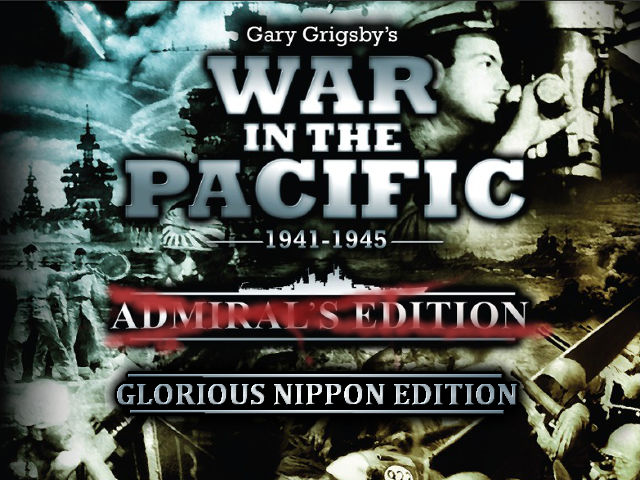 Gary Grigsby's War in the Pacific: Admiral's Edition Developer: Henderson Field Designs / 2 by 3 Games Publisher: Matrix Games Released: 2009 About the game As all WWII history connoisseurs know, most Japanese operations in the Pacific theater were directed by a single man, who was issued with a telegraph terminal, a high-school geography textbook, and a bunch of vacation pictures kindly donated by members of the General Staff (contrary to popular belief, he actually had to buy the constant supply of coffee that sustained him). Creators of the WITP took it upon themselves to accurately recreate this person's experience from 7 December 1941 until September 1945 when he died of cardiac arrest, forcing the Japanese Empire to surrender. It is an incredibly ambitious WWII wargame which claims to accurately represent and simulate every boat, battalion and plane that ever participated on war effort in a theater stretching from the Cape Town to Panama, and from Siberia to New Zealand - On a scale of one day per turn. It's also just as incredibly expensive, obtuse and intimidating. The core game was made mostly by three guys, and later expanded by a rag-tag team of pseudo-modders who thought the original wasn't Yet there is something of a thriving community around the WITP, a handful of players who again and again return to this blasted game, much like battered housewives return to their abusive husbands, knowing that deep under the rough exterior, there just must be some good qualities. And if that isn't a testament to WITP's peculiar excellence, I don't know what is. Hopefully I'll be able to convey WITP's strong side while editing out lots of its obnoxious shortcomings. So let's defend the Great East Asia Co-Prosperity Sphere, or commit seppuku together. BANZAI! About the LP This thread revives my previous attempt at playing the game. Please see the post belowe for links to archived updates! I'm playing as Japan in the standard Grand Campaign scenario, which covers the entire map, including China, for the whole duration of the war. Realism settings have been turned up to the max (only "historical first turn" is off so I could take pre-Pearl Harbor screenshots), and difficulty is "Hard". Hard difficulty gives the AI certain logistical advantages, but no combat bonuses. According to my observations, it makes the Allies less likely to rout in ground combat, and increases the rate of their air operations. The game is also patched up to the latest semi-official beta version, but I can't tell you what difference that makes. The game moves forward one day at a time, but I've committed to making each regular update summary of a week's worth of operations. In addition, I'll be preparing special reports on Japanese logistics and production (see below for details of this unique Japanese feature), as well as overviews of the various units and devices at our disposal. Planned schedule is two updates per week, give or take.
|
|
|
|

|
| # ? Apr 27, 2024 01:48 |
|
Summary: War so far This post links to completed updates. It also provides short summary for each update from the previous thread, to bring you up to speed. -Ye olde threade -WITP Primer - summary of basic game concepts. -Update 0: 7 December 1941 - Pearl Harbor is attacked, strategy for each theatre is explained in some detail. -Week I: 7 December 1941 - Malaya, the Philippines, Borneo, Hong Kong attacked. Ships fleeing Pearl Harbor attacked. -Week II: 14 December 1941 - Tarakan, Brunei, Guam conquered. Leyte invaded. American battleship massacre. -Week III: 21 December 1941 - Moulmein reached. Invasion of Mindanao, Manila besieged. -Extra update I - IJA Division overview. -Week IV: 28 December 1941 - Clark Field attacked. Palembang, Balikpapan captured. Hong Kong victory. Rabaul conquered. -Week V: 4 January 1942 - Manila captured. -Week VI: 11 January 1942 - Invasion of Celebes. -Week VII: 18 January 1942 - Moulmein, Kuala Lumpur, Malacca captured. Battle of Oosthaven. Fall of Clark Field. -Week VIII: 25 January 1942 - Battle of Johora Bahru. Invasion of the Aleutians. -Week IX: 1 February 1942 - Fall of Rangoon. -Week X: 8 February 1942 - Fall of Johoe Bahru. Invasion of Lae. -Week XI: 15 February 1942 - Battle of Singapore begins. -Week XII: 22 Fenbruary 1942 - Invasion of Java. Invasion of Ceylon. -Week XIII: 1 March 1942 - Battle of Mandalay. Fall of Colombo. -Extra update II - IJA artillery overview. -Week XIV: 8 March 1942 - Battle of Cagayan. -Week XV: 15 March 1942 -Week XVI: 22 March 1942 -Week XVIII: 29 March 1942 - Fall of Surabaya -Week XIX: 5 April 1942 -Week XX: 12 April 1942 -Week XXI: 19 April 1942 - Battle fo Myitkina. -Week XXII: 26 April 1942 - Invasion of West Australia, Geraldton. -Week XXIII: 3 May 1942 - Invasion of Flores. -Extra update III - Allied Chinese regimes. -Week XXIV: 10 May 1942 - Fall of Perth, Invasion of Kendari. -Week XXV: 17 May 1942 -Week XXVI: 24 May 1942 - Battle of Batavia. Invasion of Broome. -Week XXVII: 31 May 1942 - Fall of Batavia. -Week XXVIII: 7 June 1942 -Week XXIX: 14 June 1942 - Conquest of Lashio. Invasion of Timor. steinrokkan fucked around with this message at 19:28 on Mar 3, 2015 |
|
|
|
RESERVED
|
|
|
|
 Hello and welcome back to another edition of Empire Marches On: The Co-Prosperity Bulletin. Please pay no heed to the rumors that the recent delays in our publication's schedule have been caused by persistent paper, ink or personnel shortages in our glorious country.  To refresh your memory - In Burma we are done with the relatively easy task of conquering the Irrawady valley, and are getting ready to cross swords with the Britons in the jungles of the Indian borderlands. 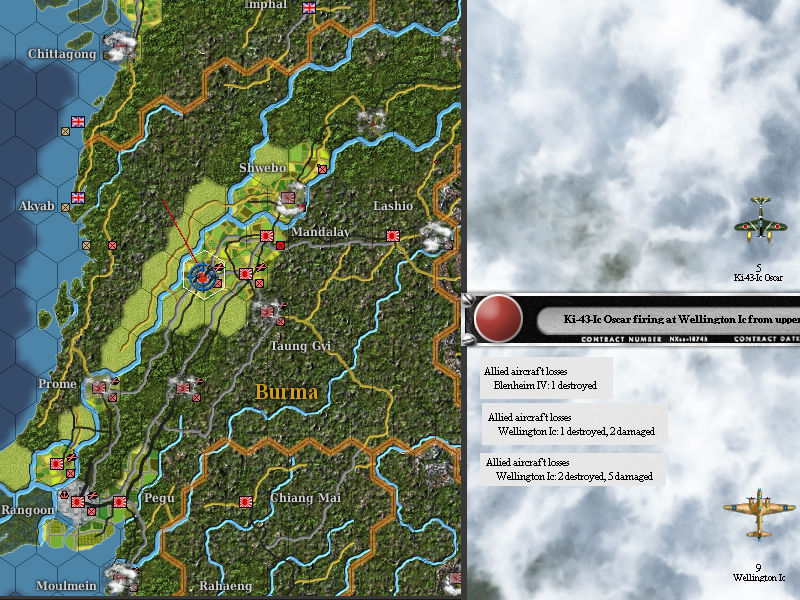 The Allied bombing campaign goes less than optimally. Despite their diminutive stature, the Oscars are showing that they have teeth. 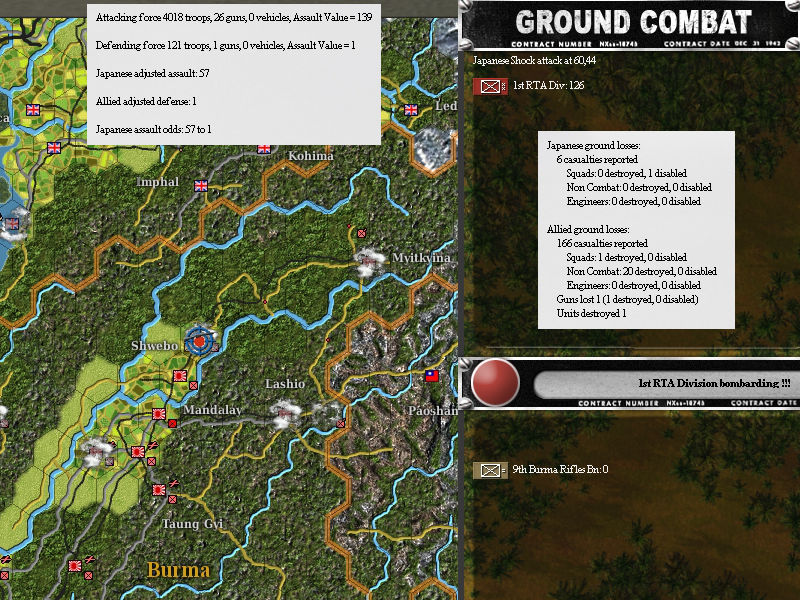 The one remaining group of British stragglers is destroyed while trying to cross the river - they won't reach Bengal any time soon. 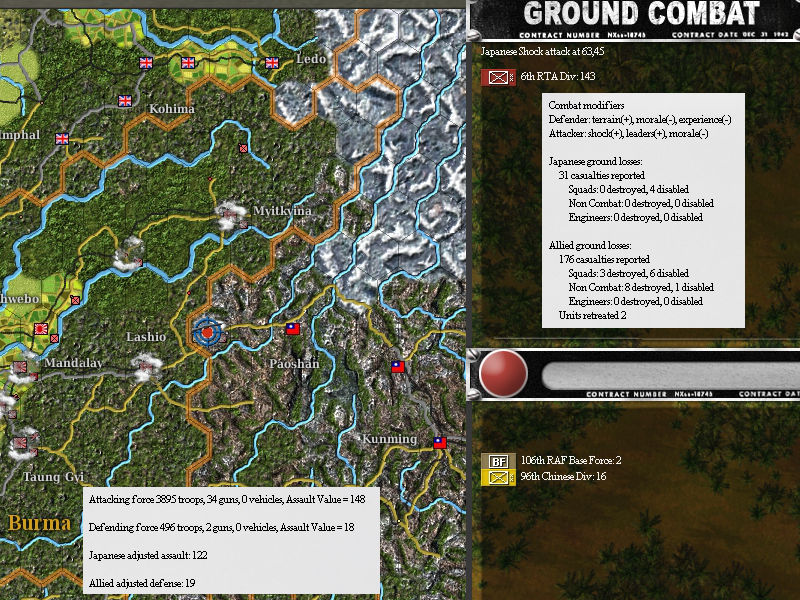 Our drive into Yunnan along the Burma road goes well. Casualties are seemingly low, but they will add up over time. 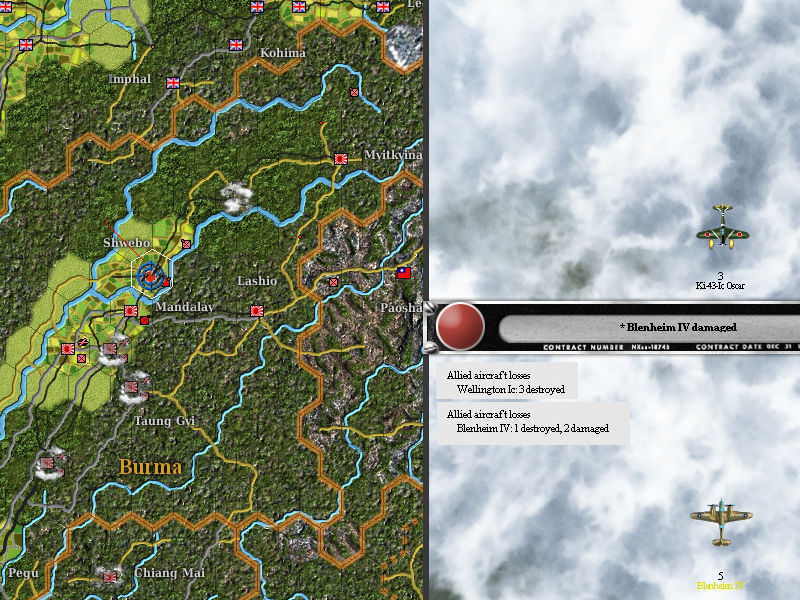 The British certainly have their eye on the prize, but they are not able to reach it.  As you may remember, Malaya is still an active front, if only due to the miraculous persistence of Singapore's defences. 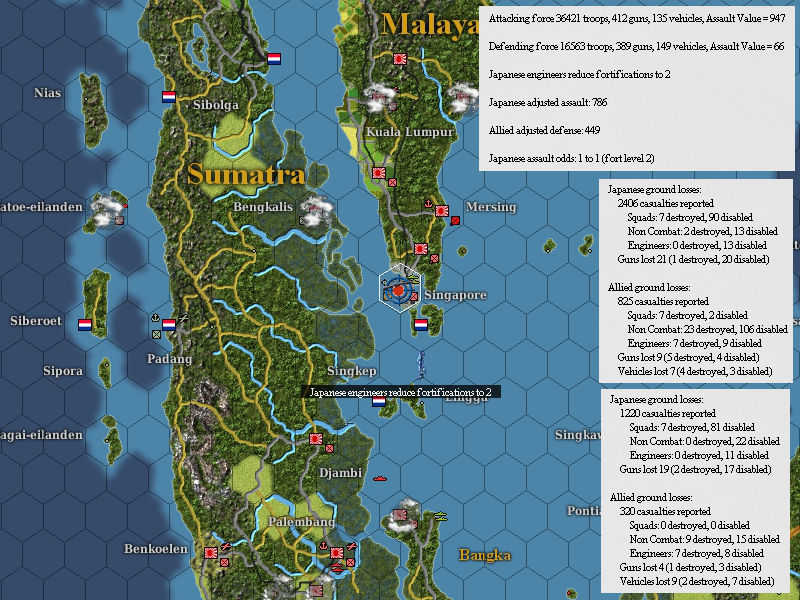 The problem remains the same - the cowardly armed forces in the city keep using their unarmed comrades as ablative armor. 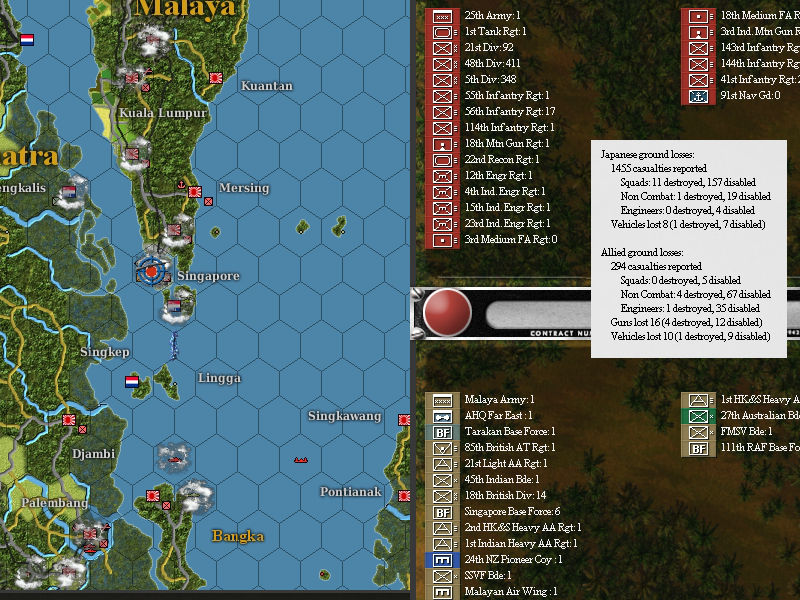 As our casualties drop, so do those of the enemy, unfortunately. Somehow the husk of the 18th British division is capable of disabling approximately half of one Japanese division on every day of combat.  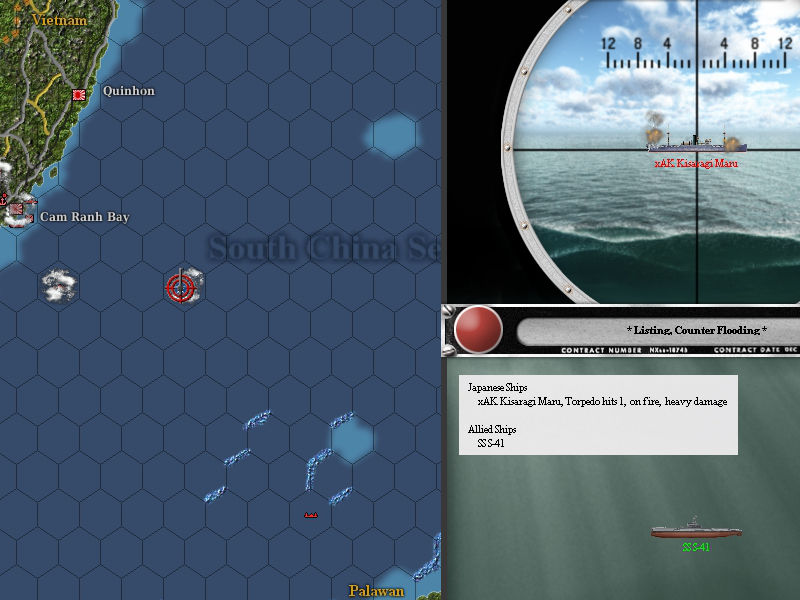 Another one of the inevitable losses to the Allied submarine campaign occurs.  In the East Indies we have already reached all our major objectives - the oil producing ports of Borneo and Sumatra are protected by a deep buffer zone of Japanese territory. Java and Timor, too, have been liberated. However, there remains a scattering of island bases that are still nominally in Dutch hands. 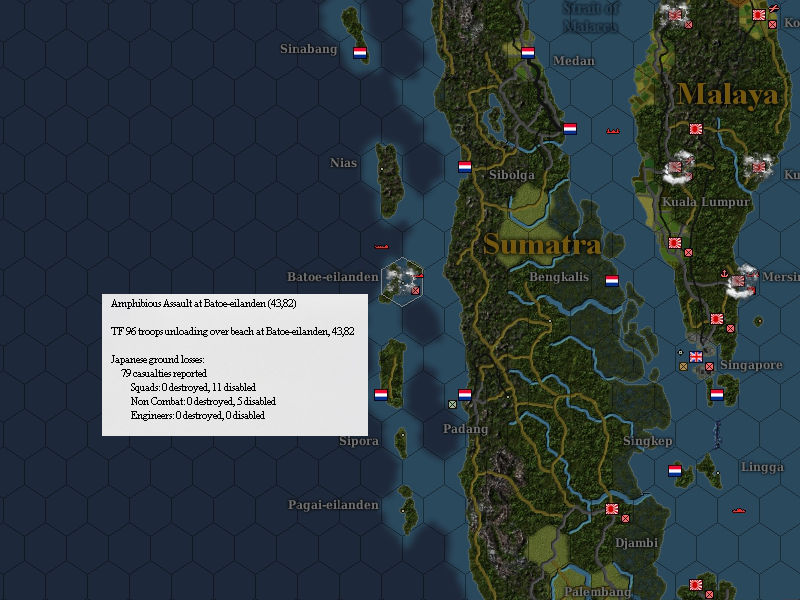 Along the Western coastline of Sumatra runs a chain of small islands. None of them are important as of now, but they could be used as difficult to displace airfields capable of hitting Palembang. Therefore, a number of Marine detachments has been dispatched to secure them. 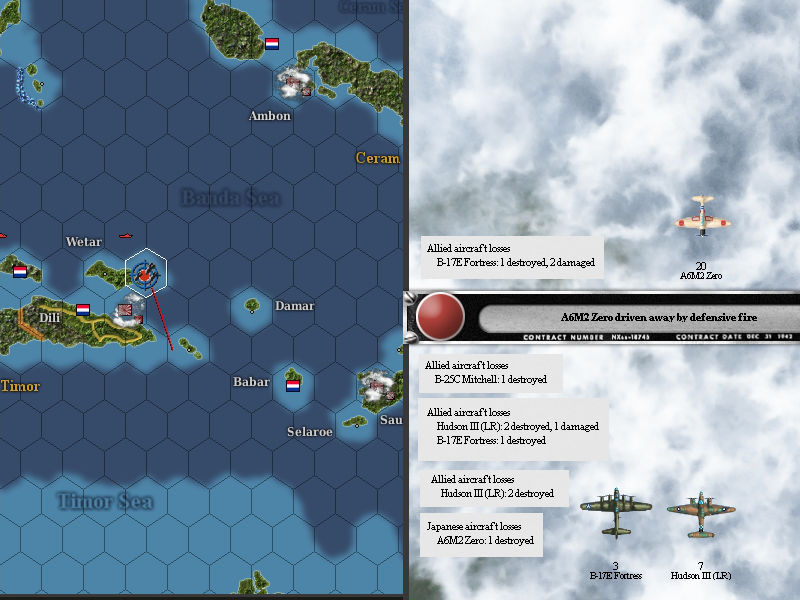 The battle of Timor is still technically ongoing, though the result is a foregone conclusion. Our carrier screen continues to protect the beaches so that vital supplies can flow freely to our boys. 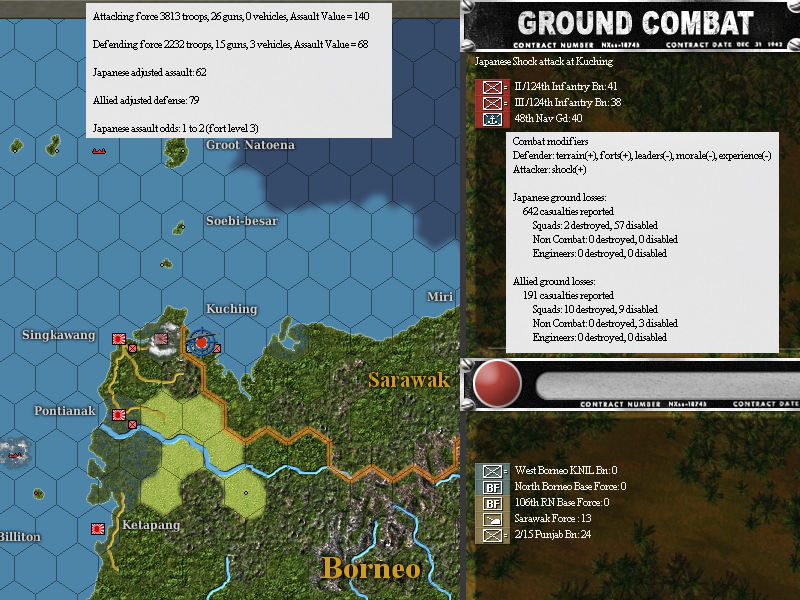 A regiment of infantry is bogged down (literally) fighting the British in a swampy stretch of wastelad. 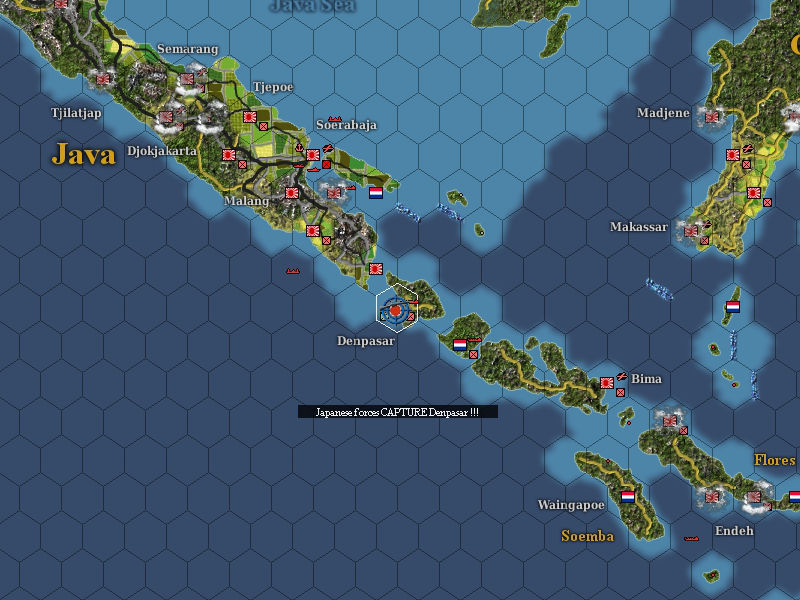 Bali is captured, and with it we gain control of the second most important naval passage in the East Indies (after the Malacca Strait). Also our travel agencies start booking vacations to this island paradise. 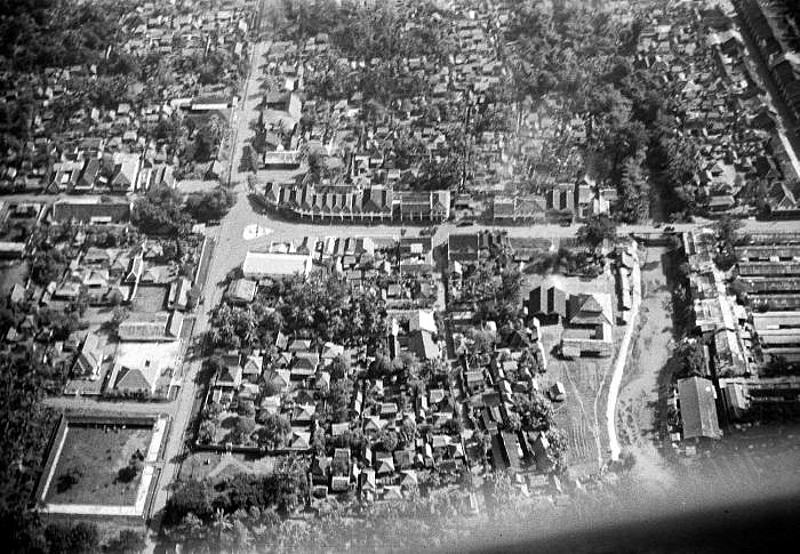 Aerial view of Denpassar THE SYDNEY MORNING HERALD, 31 August 1929 posted:IN BALI Wayside Life. 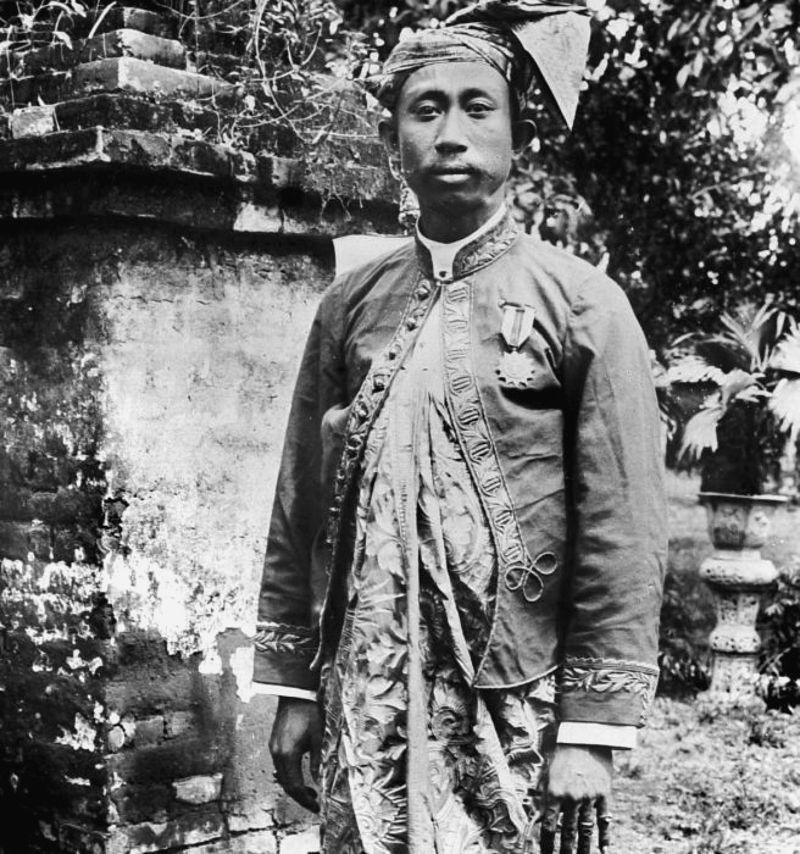 A Balinese man in the traditional garb.  The battle of Denpassar itself wasn't particularly dramatic, as the town was only lightly protected. 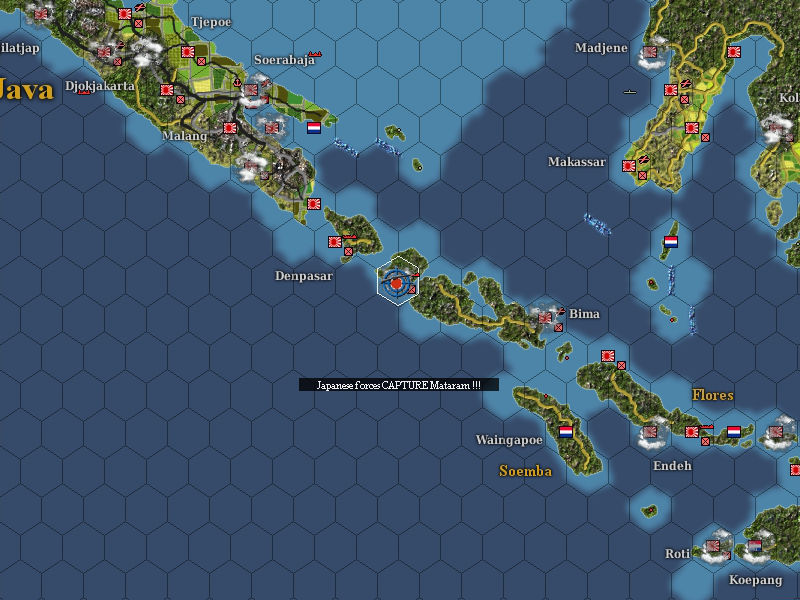 The nearby town of Mataram falls as well, and with it the Lombok island. This connects our holdings in the Lesser Sundas, and creates a continuous chain of Japanese bases from Sumatra to Timor. 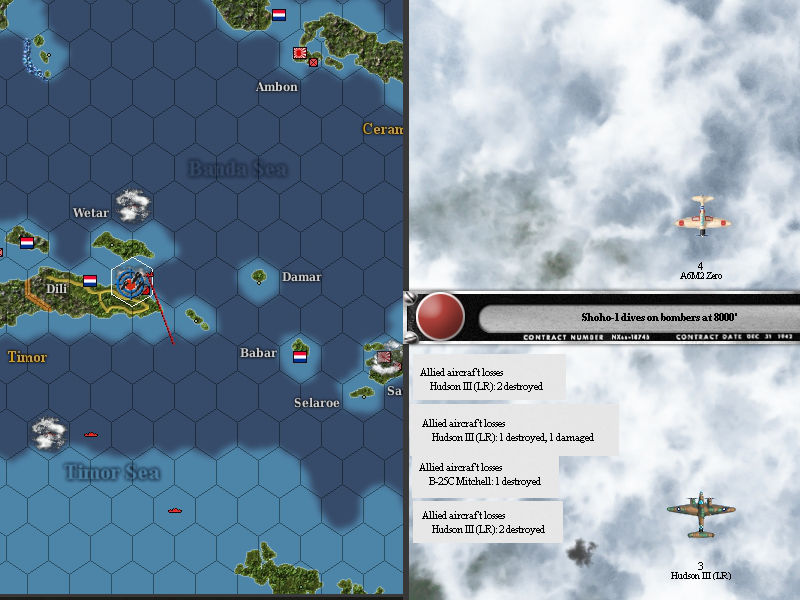 These bomber losses must be doing a number on the Allied stockpiles. 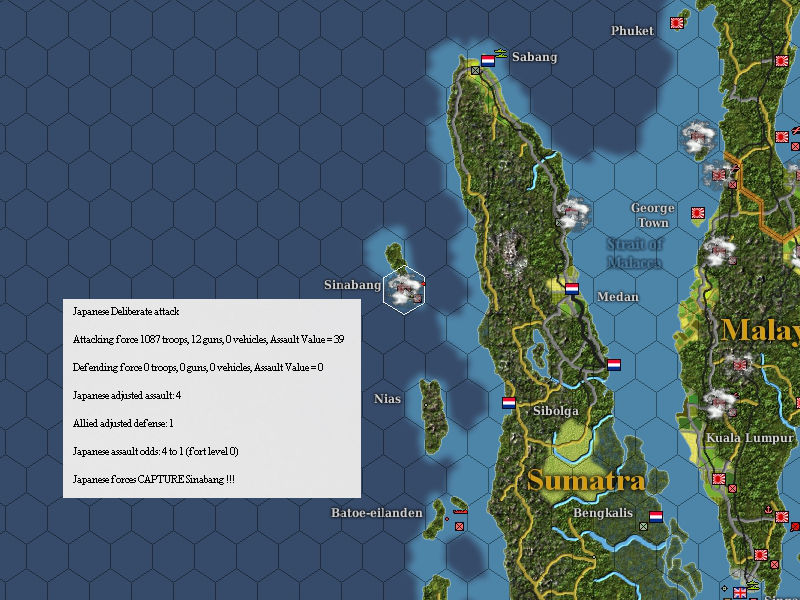 The sleepy community of Sinabang, Simeulue Island, is taken, unopposed. 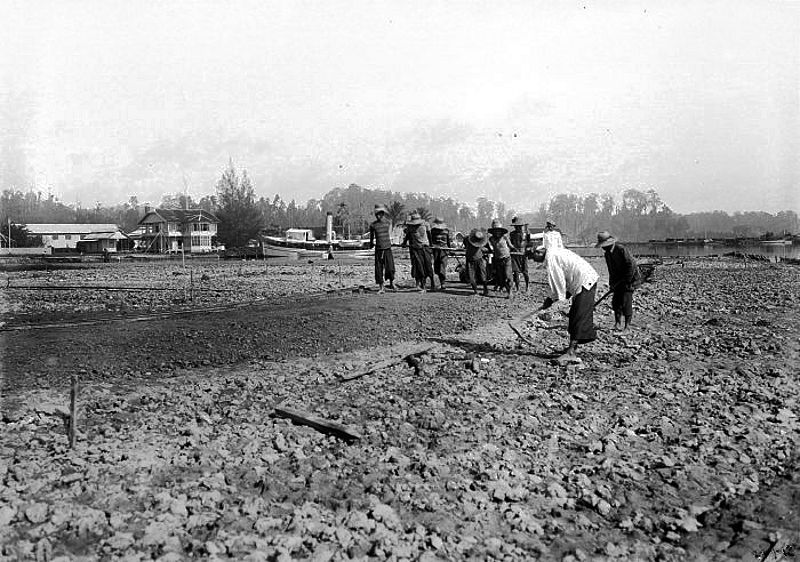 Labourers in Sinabang  In the IO we have put a severe dent into the British possessions and sea lanes by occupying Ceylon with a powerful corps of several divisions, with a strong air arm. 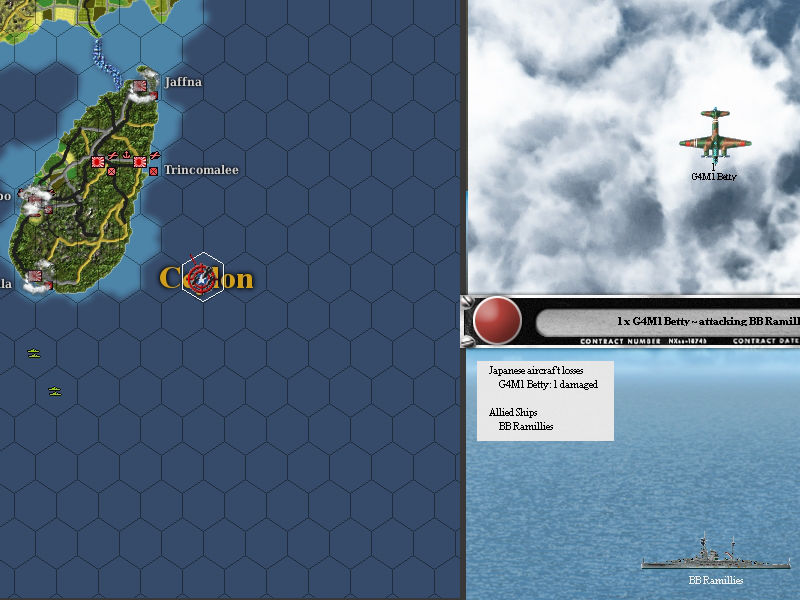 Indeed, the Royal Navy is seemingly clueless as to how to approach our stationary mega-carrier: Their battleships are loitering around, probably to interdict supplies, but with the superior intel provided by our planes, this is not an issue. 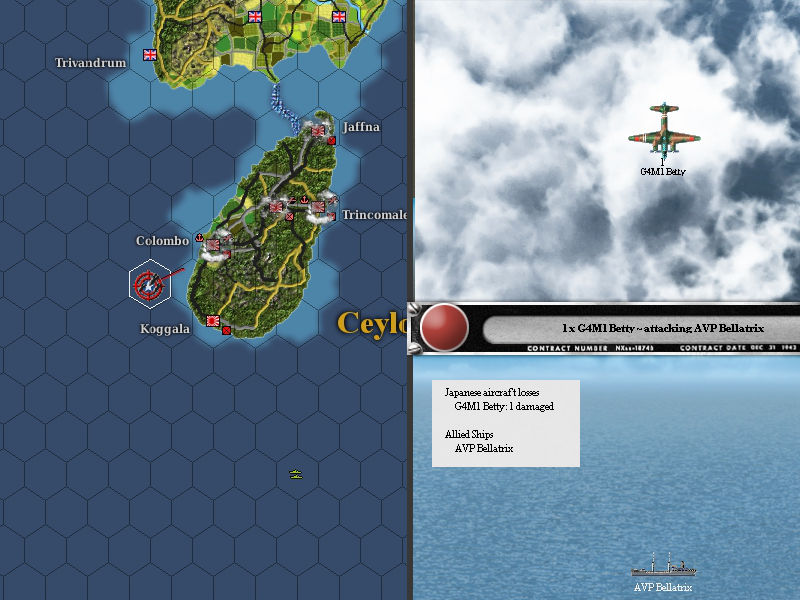 This seaplane tender must have missed the memo that Colombo is closed to business. 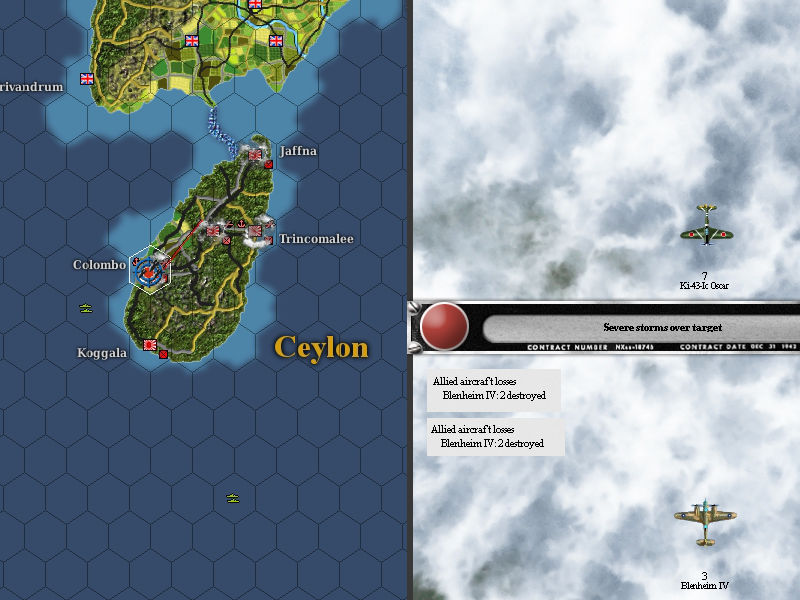 Madras and its air base are currently my only source of concern, but realistically the British efforts to reduce Ceylon are doing more harm to them than to us. 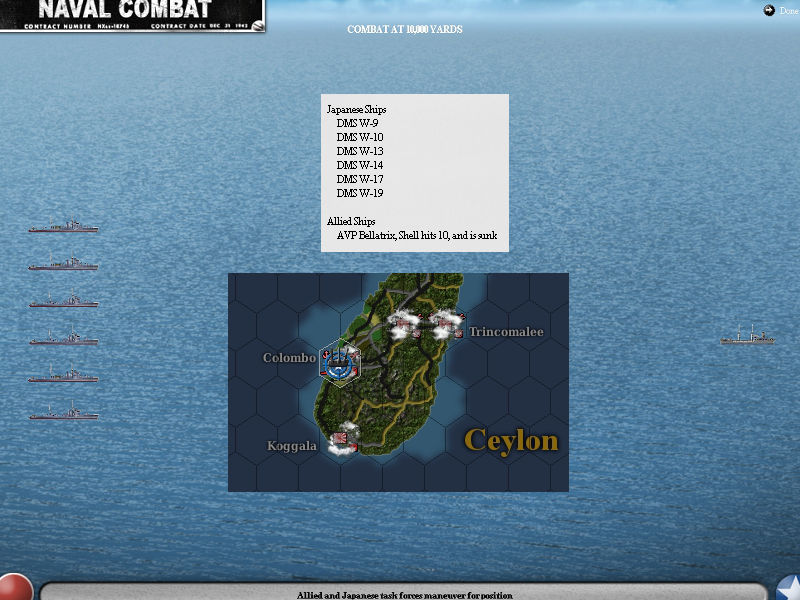 With suicidal idiocy Bellatrix continues her trip to Colombo, and is shot to pieces by our mine sweepers. 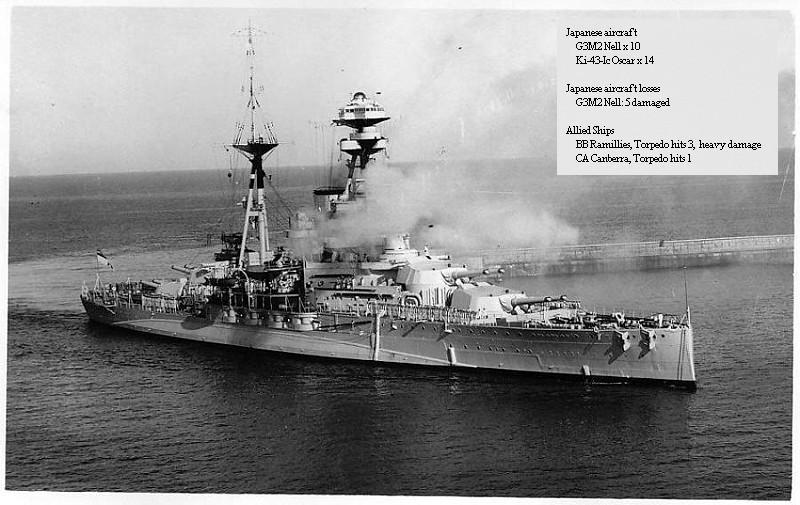 The continued presence of Ramillies allows our torpedo-equipped Nells to organize an attack, and she pays for it. Ramillies had been patrolling off the coast of Ceylon literally for months, avoiding attacks every week and earning the respect of our pilots. Now she finally pays for her hubris. 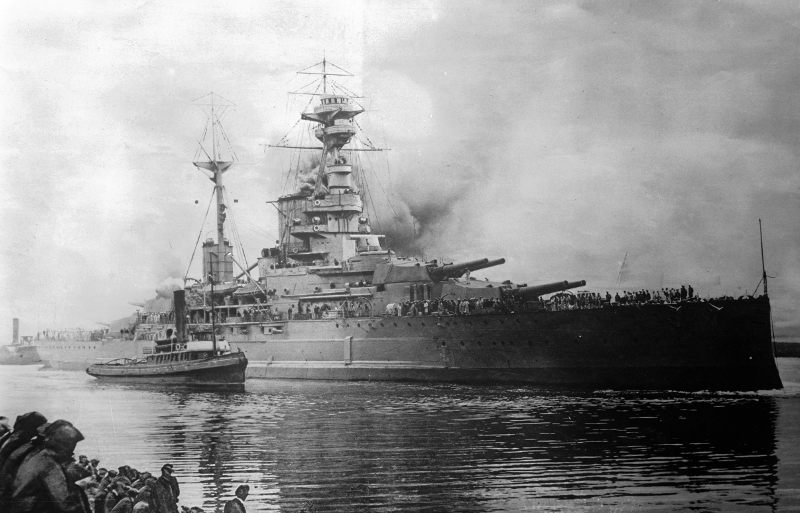 HMS Ramillies had certainly been an old veteran by the time the war started. She was laid down in 1913, but didn't reach completion until late 1917, missing the Battle of Jutland, and never having a chance to fight in the Great War. Her commissioning took so long because during launch she suffered damage to the rudder, which led to lengthy repairs. Her first assignment of note came in 1920, when she was ordered to shell Turkish positions to pacify the British-occupied territory along the Black Sea straits. Later in the 1929 she was used to intimidate rebellious populace in the Palestine. Throughout the inter-war period Ramillies was gradually modernized. Her AA armaments were greatly enhanced, her torpedo bulges and torpedo tubes removed, and overall attempts were made to lighten her. The reason was that she was no longer capable of keeping up with the battlewagons of other nations, or even with modernized British BBs of other classes. While other battleships were pushing 30 knots, Ramillies, a Revenge-class ship, struggled to reach 20 knots, and her design made it difficult to improve her performance. By the end of 1939 Ramillies was transferred to the Indian Ocean, notably carrying Prince Philip aboard. She served as a convoy escort, but in June 1940, with the outbreak of war in France, she returned to the Mediterranean to keep in check the Italian Navy. Her most notable engagement in this theatre was the battle of Cape Spartivento, which, while without heavy casualties, discouraged the Italians from making bold moves against British targets. With the dawn of 1941, Ramillies moved to the Atlantic, where she went through her most famous exploits. She proved herself as an effective convoy escort, capable of deterring surface raiders from attempting attacks. After the battle of the Bismarck vs. the Hood, Ramillies was alerted to the possibility of the German battleship attacking North Atlantic convoys. She steamed forth to challenge the Bismarck, should she make a move. However, the damaged Bismarck didn't move north, making Ramillies' posturing valiant, but without effect - which was probably a good thing, since she was heavily outclassed by the German ships. In March 1942 Ramillies reached Madagascar as part of the British invasion fleet. She dropped anchor in the northern port town Antsiranana, where she tried to repel Japanese raids. Nevertheless, she instead became victim of one of the few successful midget submarine attacks: She ate a torpedo in May 1942, and though not destroyed was badly crippled. This incident put her out of service until mid-1943. While undergoing repairs she was refitted to face more adequately the leading aerial threats of the day: New deck plating was to protect against dive bomber penetrating attacks, and several gun mounts were dismantled and replaced with additional AA weapons. She remained in the Atlantic, and covered the D-Day landings. Her batteries destroyed German shore gun emplacements, and her remaining light guns repelled a determined attack by German torpedo boats, which launched several torpedoes against her, unsuccessfully. Over the course of more than a week of shelling, Ramillies fired a record number of rounds, and destroyed a great number of different targets while only suffering very light damage from land artillery. She then provided more shore bombardment services in Southern France. Afterwards, however, there was no combat role left for the old battleship. She retired from the front, and served for some time as a barrack ship in England. In 1946 she was sold for scrap, and finally broken up in 1949. 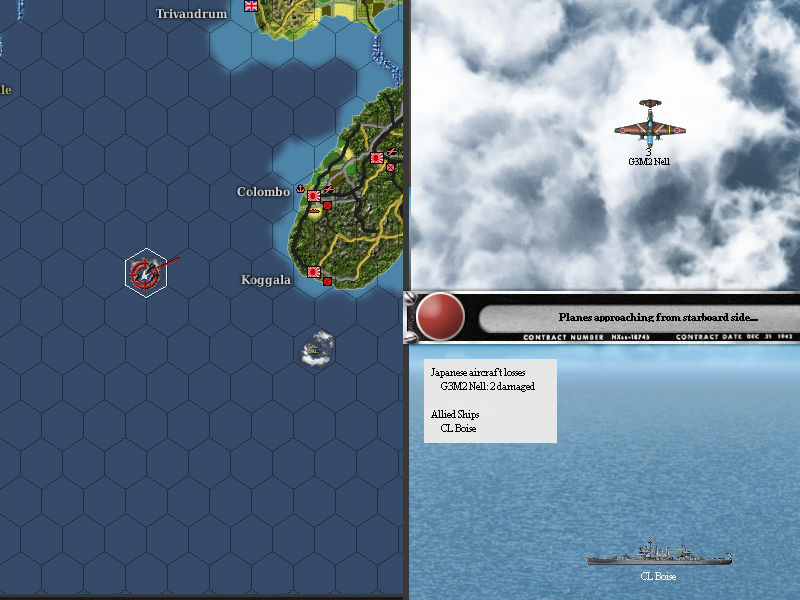 Americans have a presence in the IO, too.  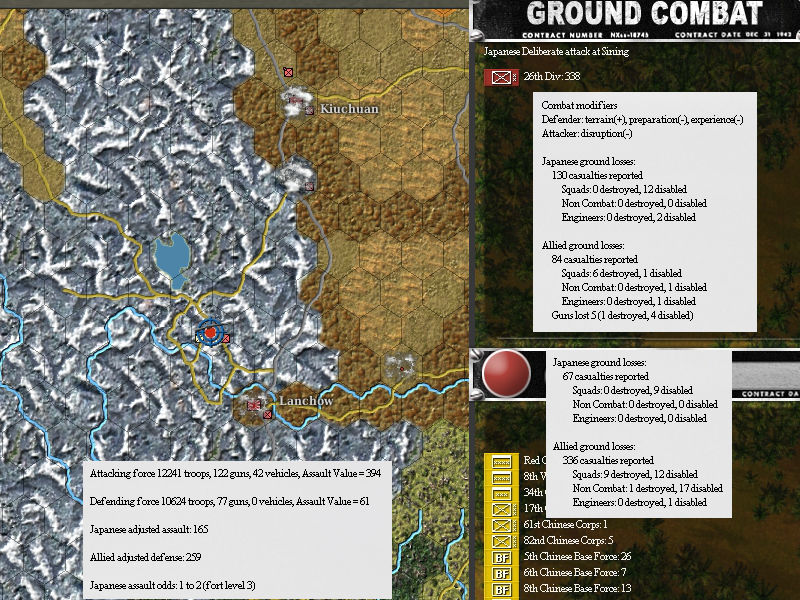 We attempt to push the surviving Chinese defendants of Lanchow towards the scenic Kokonor / Qinghai Lake, but the hostile terrain won't allow us. 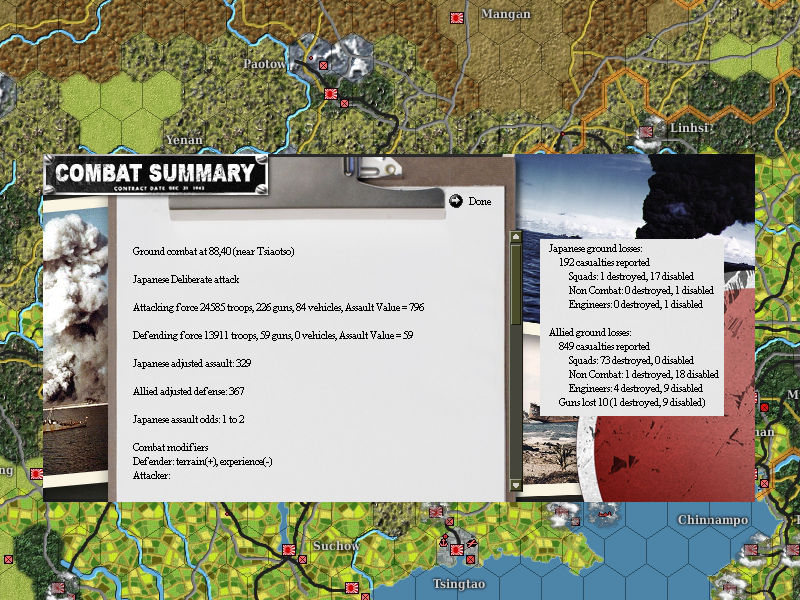 Even in milder climate the Chinese somehow cling onto their land, despite the odds. 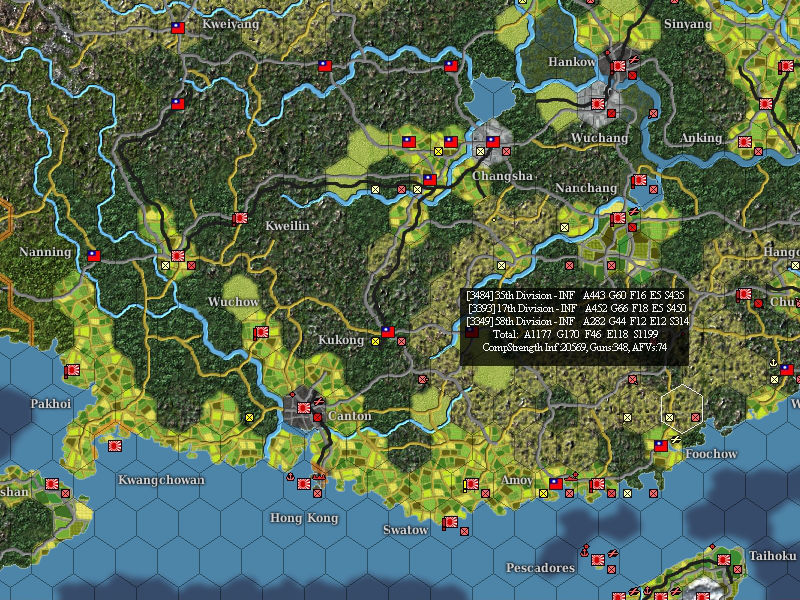 I'm forming up an offensive force in the vicinity of Nanchang to push across the river towards Changsha. I hope to encircle this Chinese stronghold quite soon.  We are about to wrangle the coastal towns remaining under Chinese control. 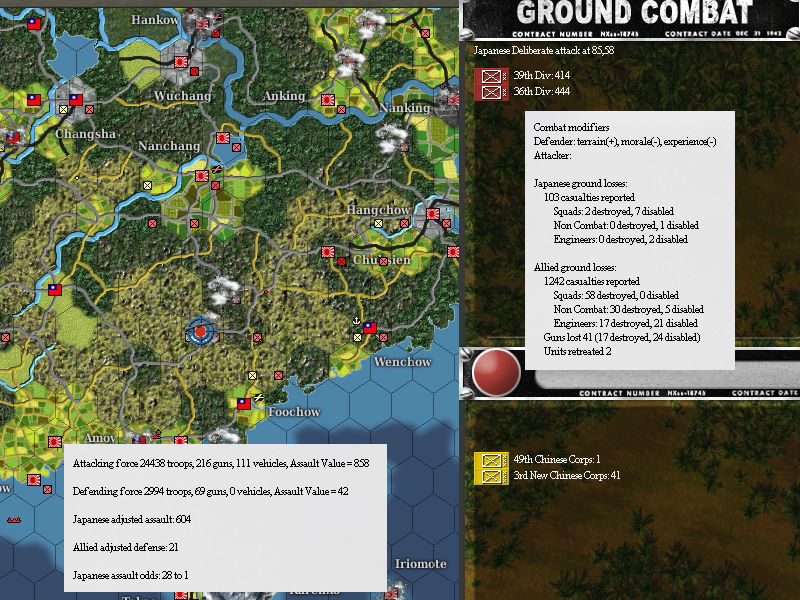 Our control over the inland stretches of land is being consolidated as well. 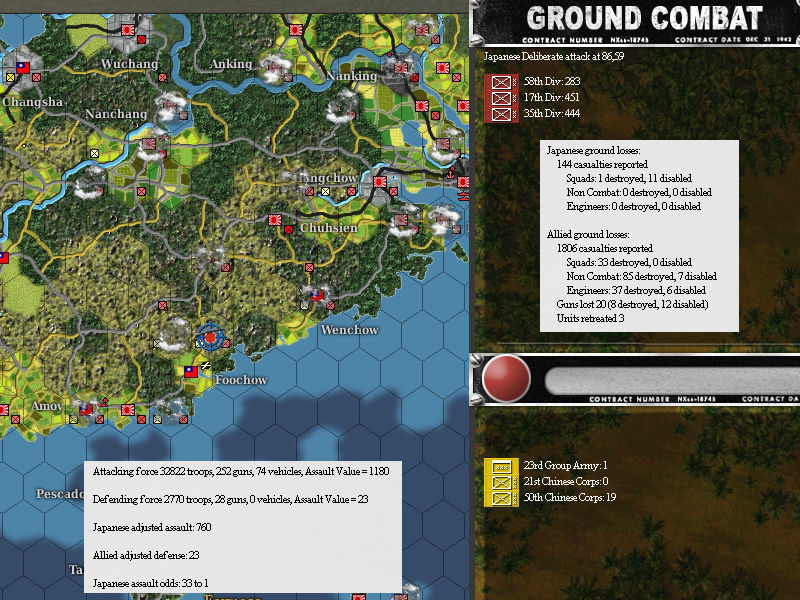 Foochow, your time is near.  The week ends with the Qinghai battle still going on. 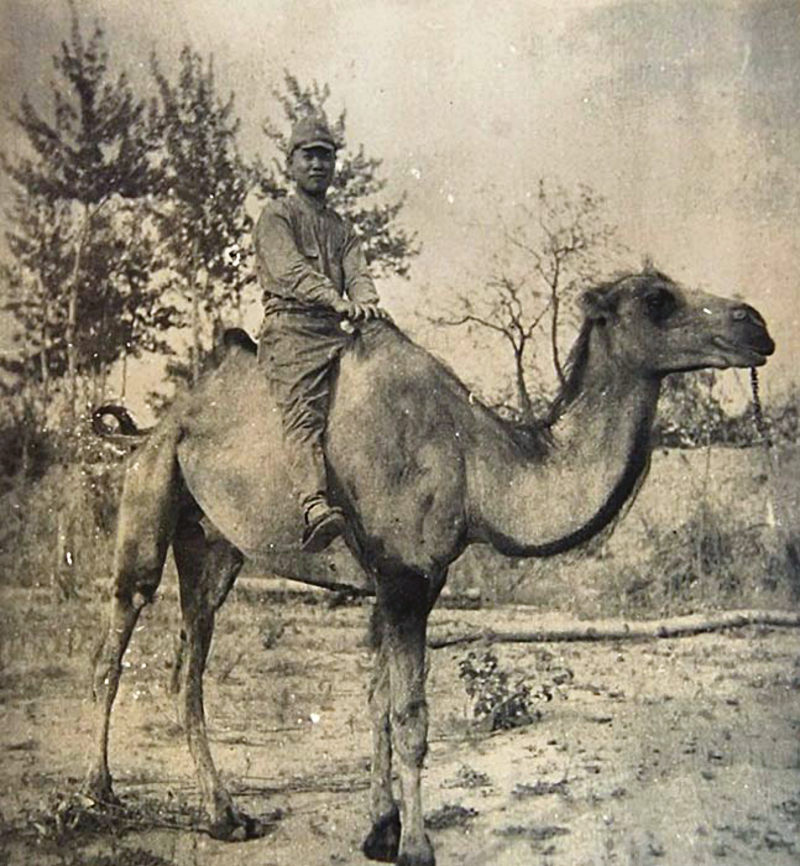 Japanese general staff hopes that battle camels will help us break the stalemate in the inhospitable soda lake basin that serves as our Qinghai battlefield.  In New Guinea our obvious target is Port Moresby. While it may appear that it's too late in the war to contest the control of this strategically important port, I dare to disagree. 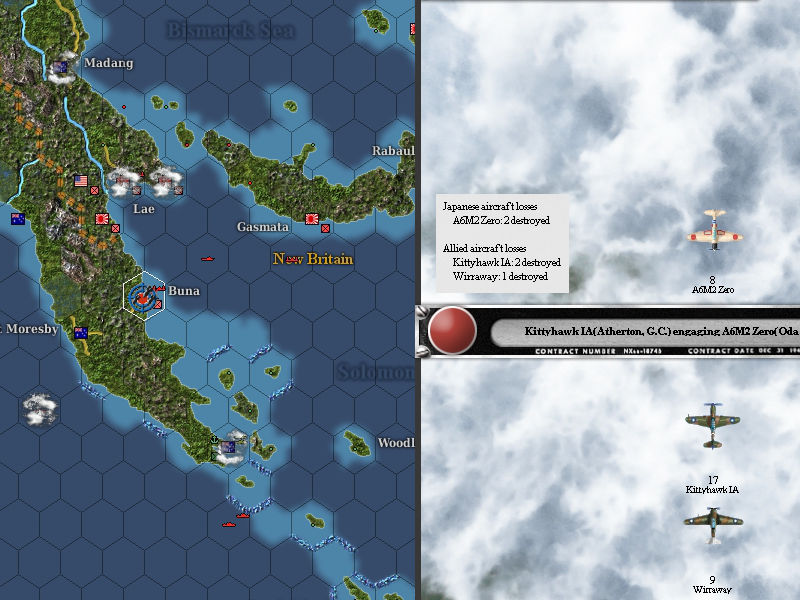 Without Port Moresby we will never be able to safely supply our defenders of the Northern coast of New Guinea. Right now they are only sending Wirraways against us, but we have seen what PM-based Dauntlesses / Banshees can do. THE COURIER MAIL, 30 July 1942 posted:JAPANESE SURPRISE AT BUNA TEACHES BIG LESSONS IN AUSTRALIA'S TASK 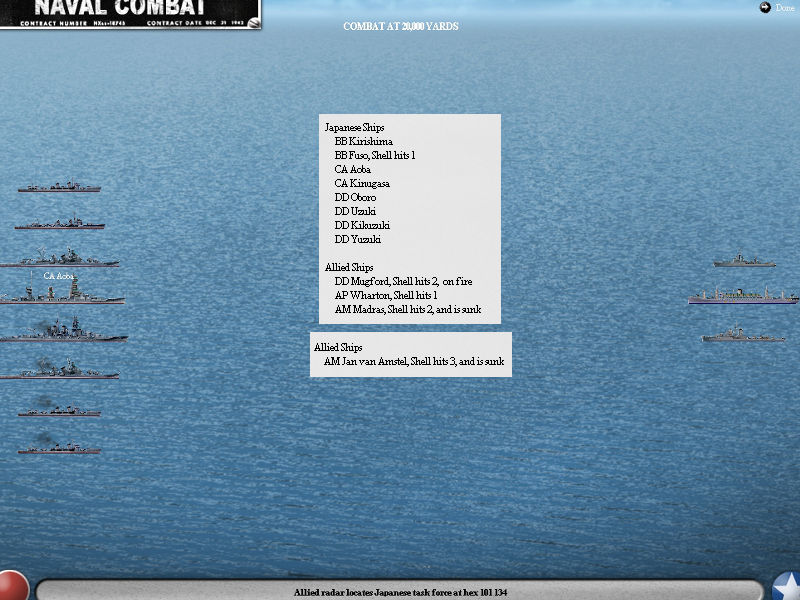 Surface raiders move past the Milne Bay and attack Allied shipping, with limited success. 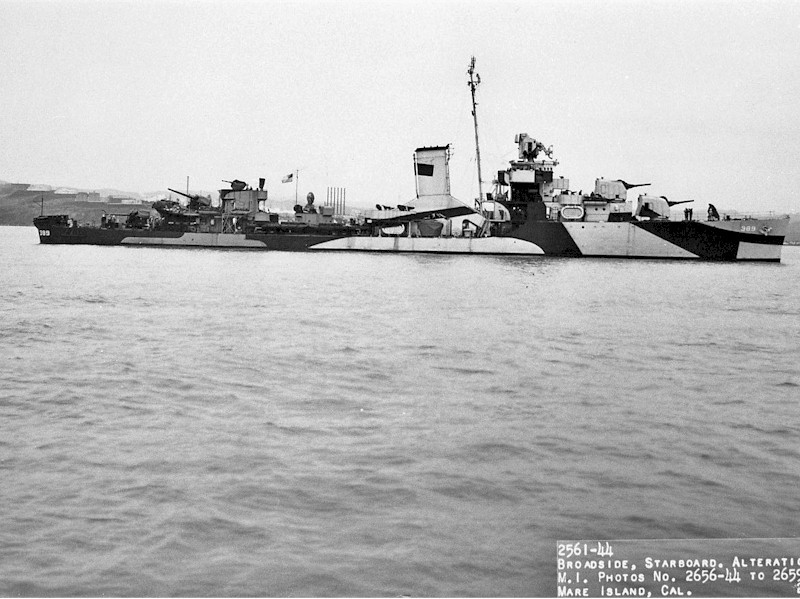 USS, Mugford, a Bagley class destroyer. Built in 1935, Mugford served in the Pacific from 1937 on. When Pearl Harbor came under attack, Mugford was stationed in the yard, scheduled for repairs. Despite that, she quickly fired up her boilers and charged out of the base, attacking Japanese planes with her .50 cal machine guns and 5 inch guns. According to the operational reports, Mugford fired almost 300 5" rounds and 5000 machine gun rounds, downing three Japanese bombers. She then steamed to Wake to provide cover for relief operations, and for the next several months proceeded to escort ships to Australia. Between August 7 and August 9 1942 she fought heavy battles against Japanese planes at Lunga, Guadalcanal. Despite direct hits and sustained crew casualties, she was able to help the stranded sailors of USS Astoria and USS Vincennes after the lost battle of Savo Island. For the rest of the year, and the whole of 1943 Mugford patrolled around New Guinea and in the Coral Sea. She helped during the invasion of Buna, where she suffered more damage and casualties from air attacks. In 1944 she escorted capital ships and carriers to attack the Marianas, and later on escorted carriers as they approached the Japanese during what would become the battle of the Philippine Sea. She saw further action at Guam, in the Mindanao Sea, and most notably in the Leyte Gulf. When the carriers Enterprise and Franklin became damaged in an action following the Battle of The Leyte Gulf, Mugford was there to protect them during withdrawal. Before the year was over Mugford managed to attract more enemy attention, and was damaged by a kamikaze pilot, losing eight more men. This attack necessitated repairs that would keep her in port until March 1945. She stayed out of main areas of action for the rest of the war, patrolling around Saipan, and after the cease fire transported POWs. Chosen for nuclear tests in 1946, she remained as an experimental ship until her sinking in 1948. 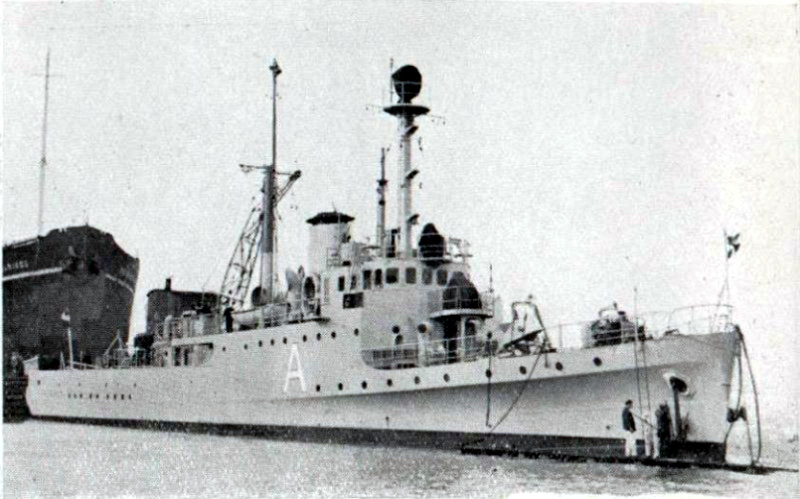 HNLMS Jan Van Amstel, 1936, was the lead ship of her class of Dutch minesweepers. At less than 500 tonnes and with only a single 75mm gun and some MGs for armament she is hardly a valuable prize, but I consider any destroyed Dutch ship a notable event. She was one of the many ships that failed to escape from Java to Australia. Her run was ruined by March 6 1942 attack by a Japanese bomber in Surabaya that badly damaged her and killed 23 people aboard - half of the full complement of her class. Two days later she was found by a IJN destroyer which put an end to her misery. 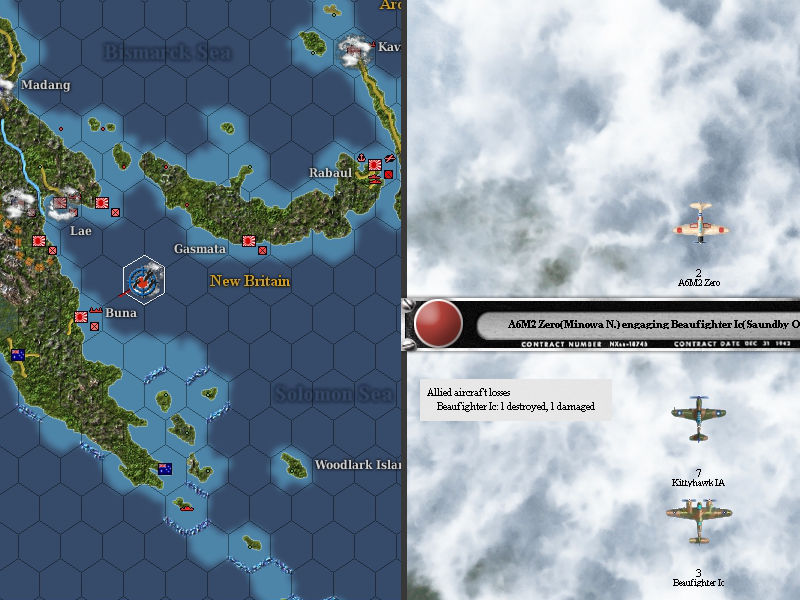 We continue blocking Allied naval attacks. 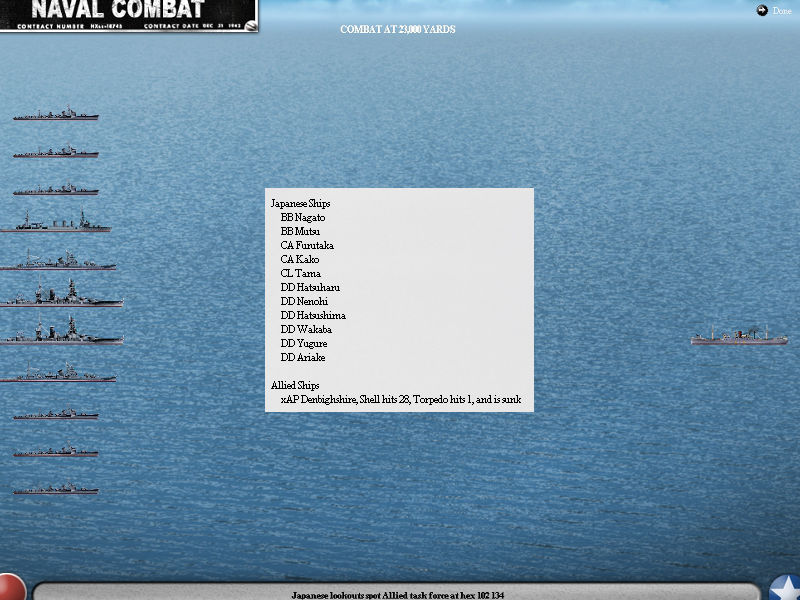 A lone merchant is destroyed in what is possibly a slight overkill. 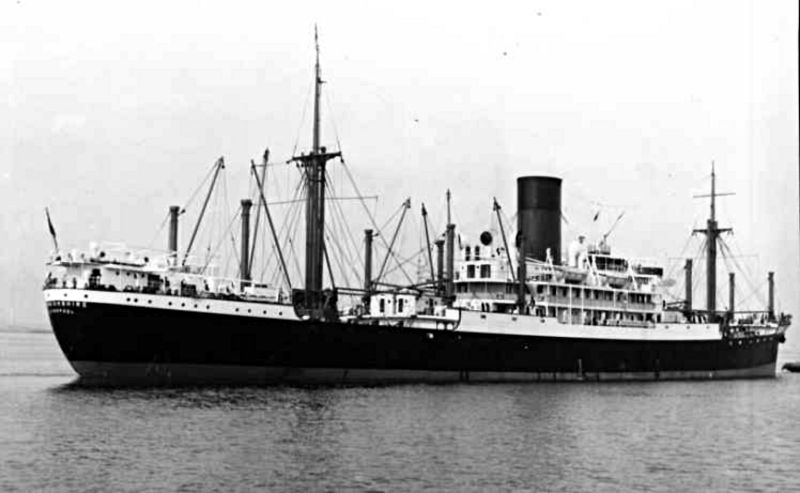 MV Debingshire, a steamboat of the minor operator Glen Line. She was built in the Netherlands in 1938, with respectable tonnage just short of 9000 tons. During the war she participated in convoys to Malta, and later on made several dangerous solo runs between Malta and Alexandria. Her later service in the Pacific was uneventful, and she was returned to owner in 1946. Her peacetime career was quite long - in 1967 she changed hands and entered the Blue Funnel Line inventory under the name Sarpedon, where she lasted until 1969.  Beaufighters are unfortunately quite hardy, and we can't count on shooting them down reliably. 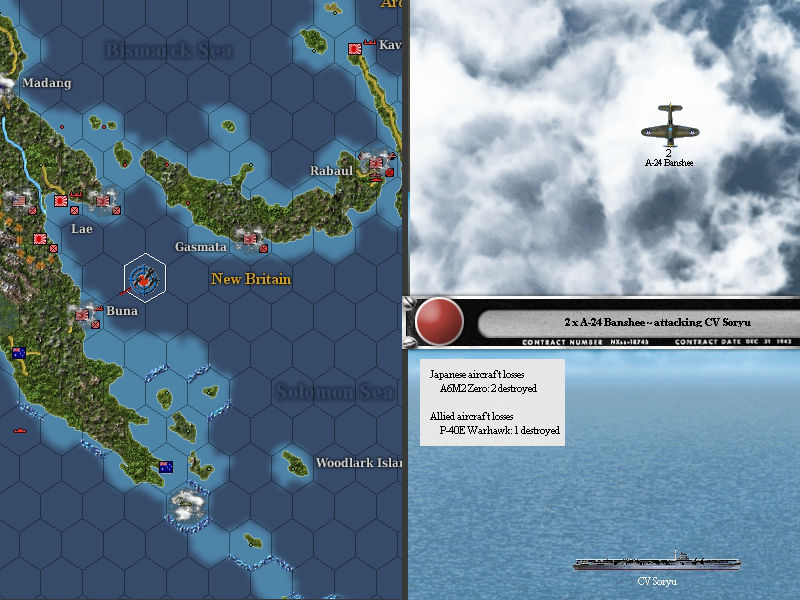 A short feeling of unease as the Allies get within sight of the parked carriers. 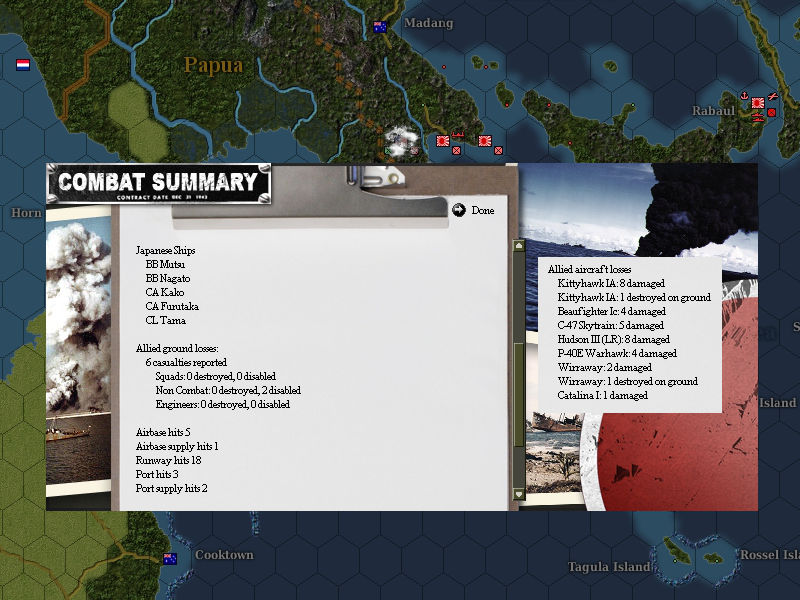 Battleships reach Port Moresby for another bombardment, this time with only modest returns. 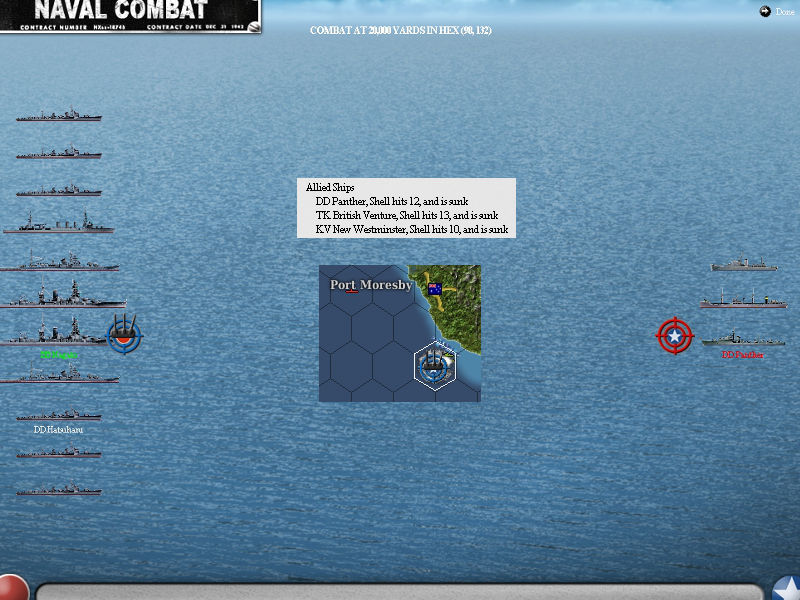 On the return voyage, however, we bag few relatively worthwhile targets. 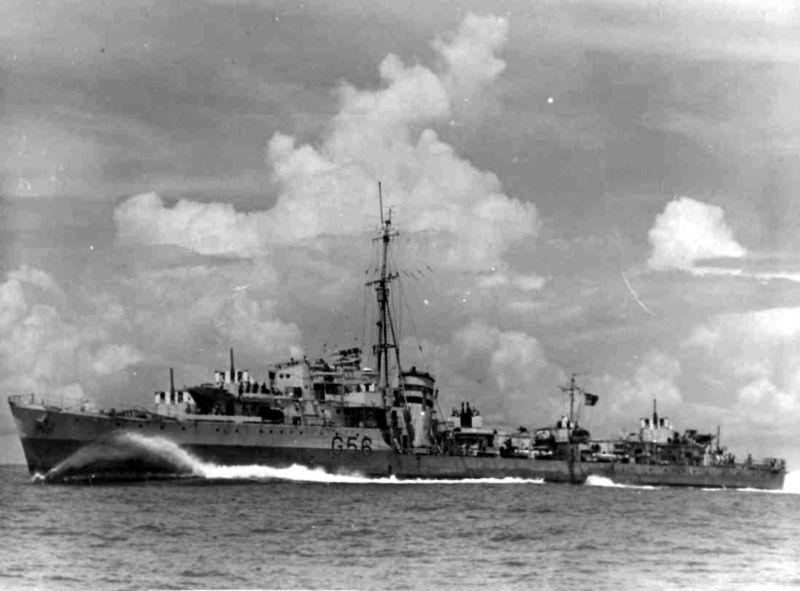 HMS Panther of the P-Class. A recently commissioned (December 1941) warship, Panther saw the aftermath of the Indian Ocean raids, saving survivors of the cruisers Cornwall and Dorsetshire in April 1942. She also patrolled around Madagascar and escorted convoys. In December 1942 she was there to witness the sinking of troopship Strahallan by a German submarine following the Operation Torch, and initiated rescue operations. The sinking of Strahallan was notable because it carried hundreds of nurses of American field hospitals, and aides to General Eisenhower. After short stays in the Mediterranean and the North Atlantic she screened the Sicily landings, and participated on the unsuccessful Dodecanese campaign when she was destroyed by a German dive bomber, in October 1943.  HMCS New Westminster, another Canadian Flower-class corvette. Commissioned in January 1942, so she wasn't granted a very long career in this game. Interestingly she is supposed to be patrolling routes between Labrador, New York and Boston at this point in the war, and remain in that station until some time in 1943. So what is she doing in the Pacific? 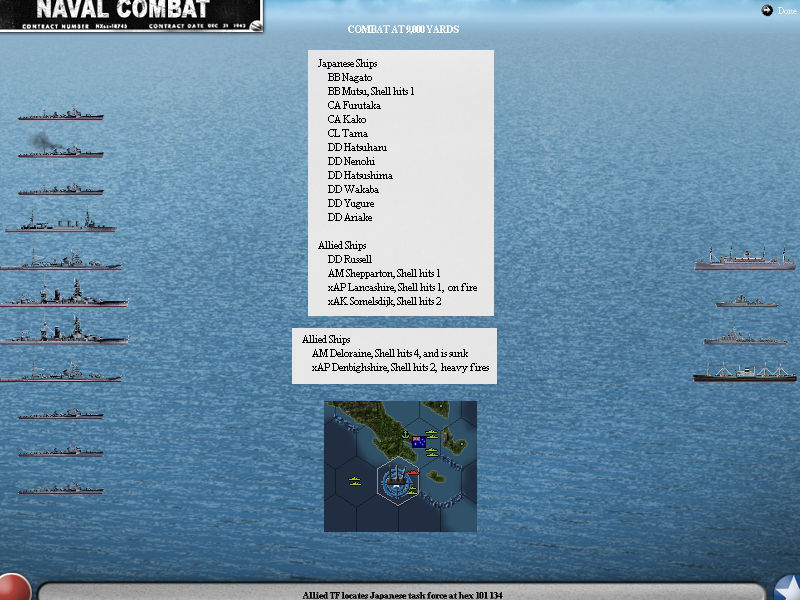 The waters around the Milne Bay are as busy as always. 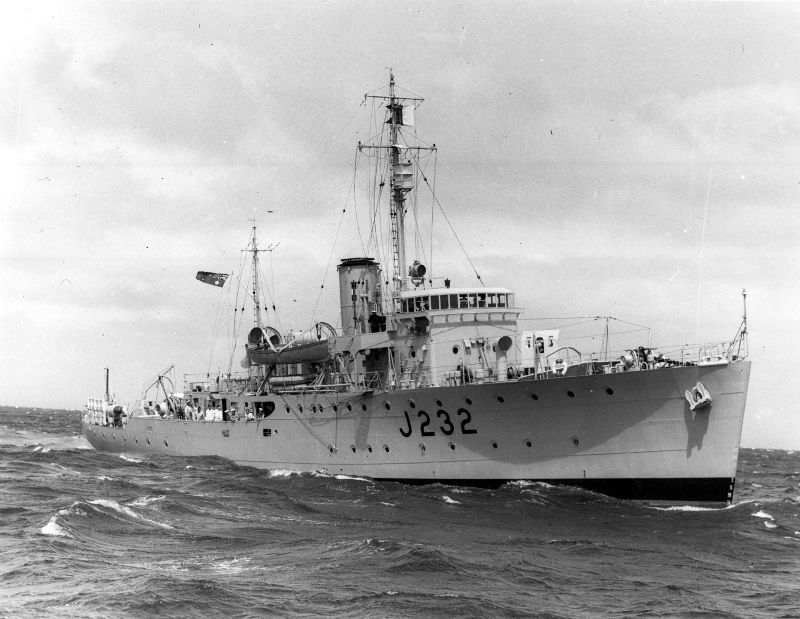 HMAS Deloraine - this week we sure make the effort to sink ships of every navy at New Guinea! She wasn't anything special, just one of the numerous Bathurst corvettes. She started the war patrolling north of Darwin, and in January was attacked by the Japanese submarine minelayer I-124, which it destroyed in the ensuing hunt. She remained near Darwin even during Japanese raids on the town, and despite her active role in providing relief to the port, she survived undamaged. She spent most of the remaining war on ASW patrols, occassionally steaming to assist the crew of a sunk Allied boat. In 1945, however, she took an offensive role in assaulting remaining Japanese positions in New Guinea. These missions were her final duty, and the cease-fire caught her in refit. She was sold for scrap in 1956. 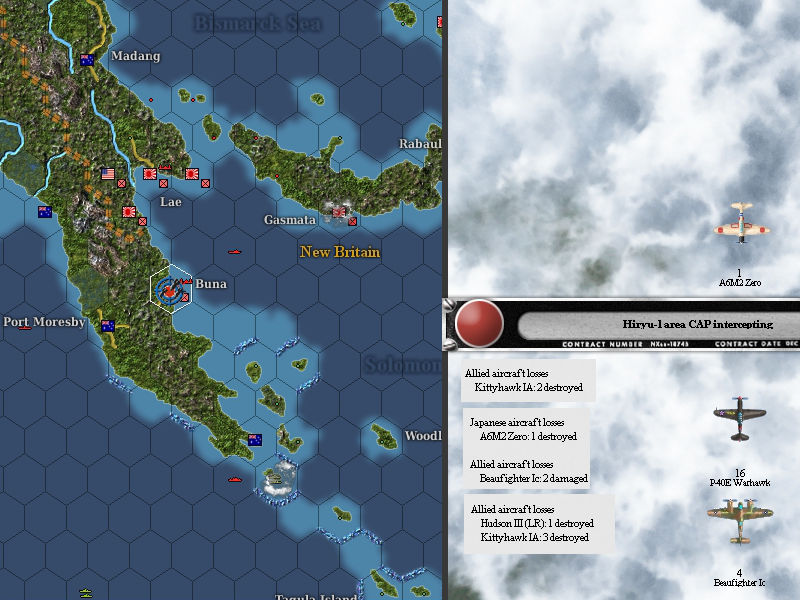 More fighter waves are taken down above Buna. 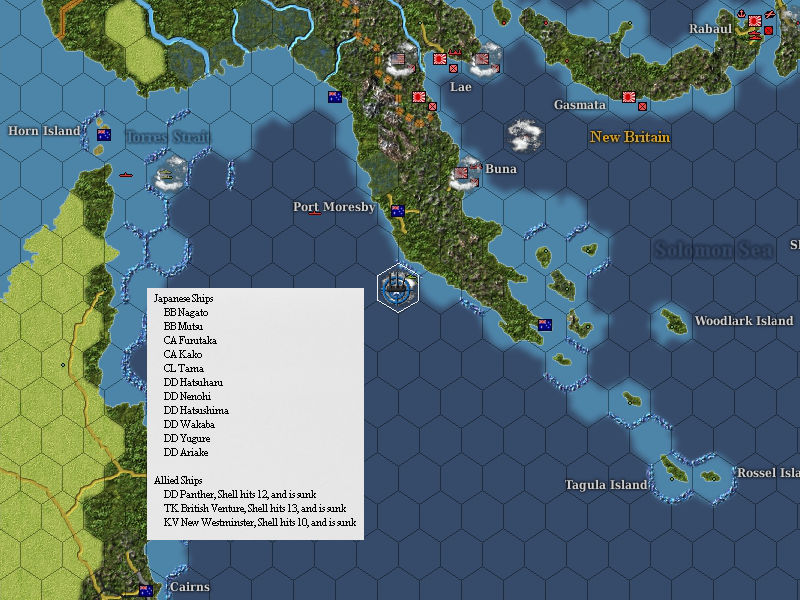 The surface fleets encounter some old acquaintances, previously presumed dead. 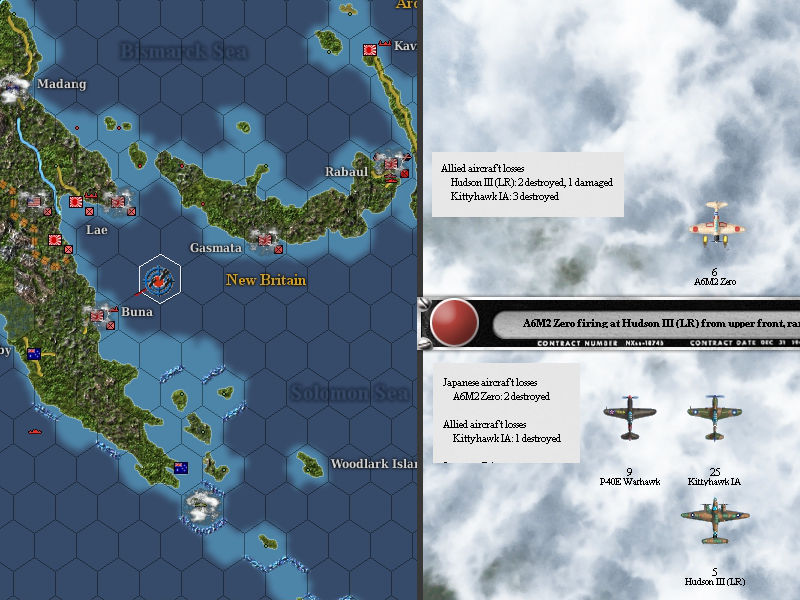 The Allies attempt another ill-fated attack directly against our carriers. The results we have been getting are great, but we probably won't be able to keep up the CAP for much longer. 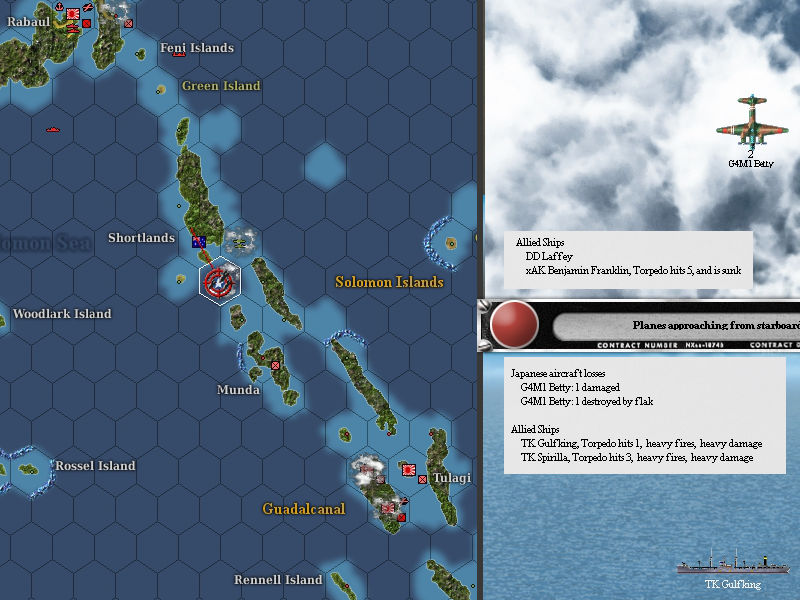 Rabaul Betties get into play, with magnificent results. 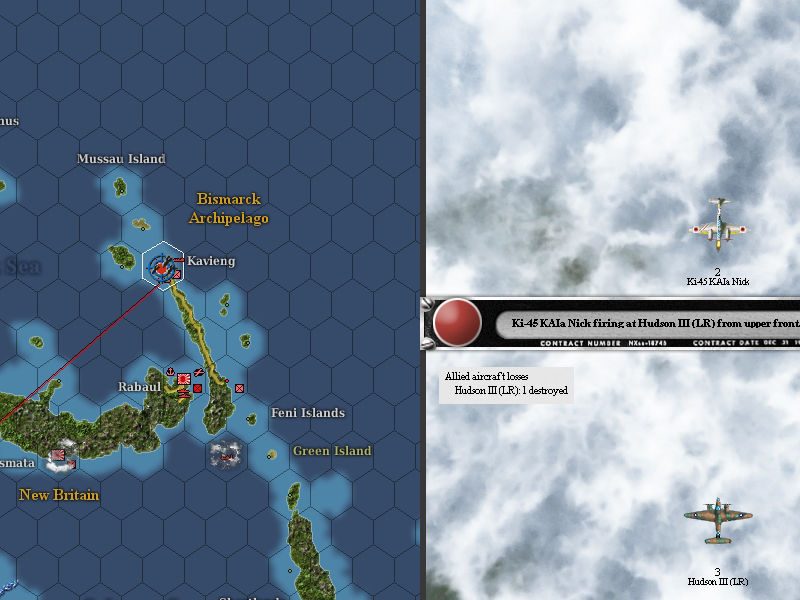 Hudsons reach New Ireland, in what is quite an improbable attack.  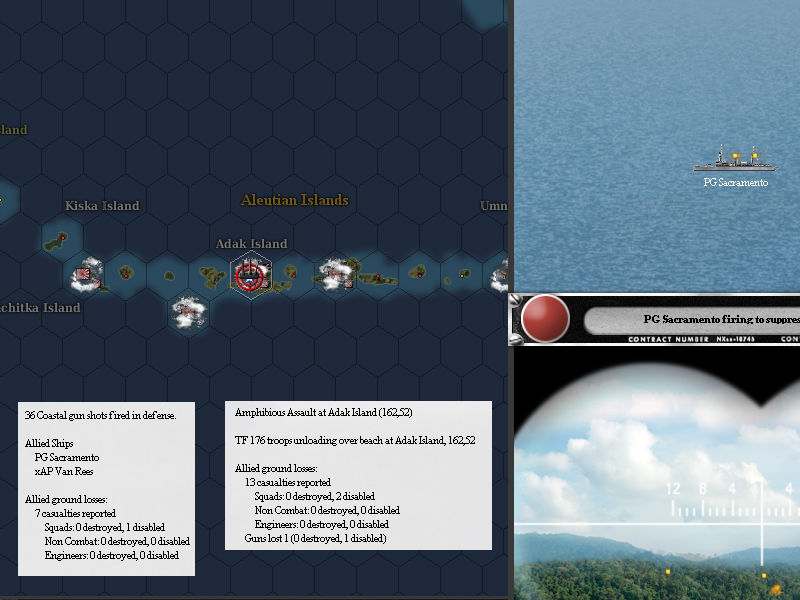 Shock, horror, awe! The Allies attempt what I believe to be their first amphibious attack of the war. 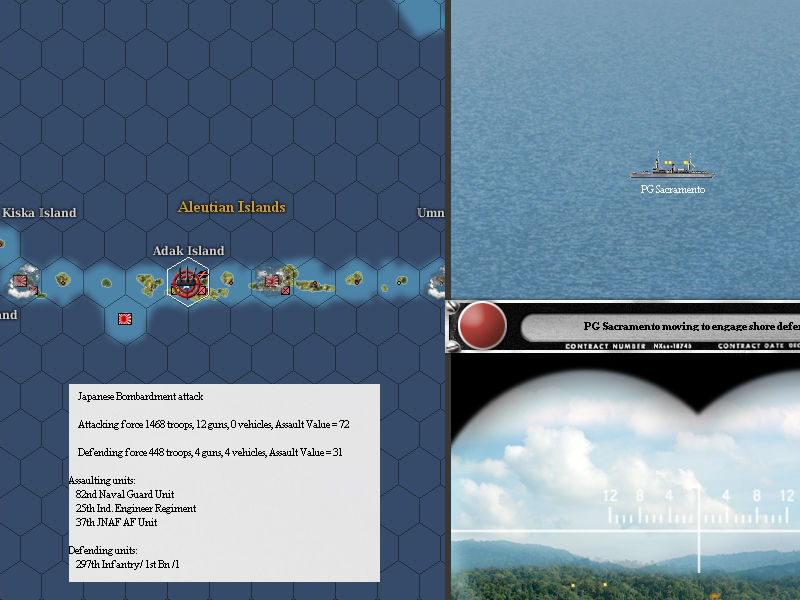 They don't attack from the beachfronts, however, and the reason is obvious: They brought way too few men. 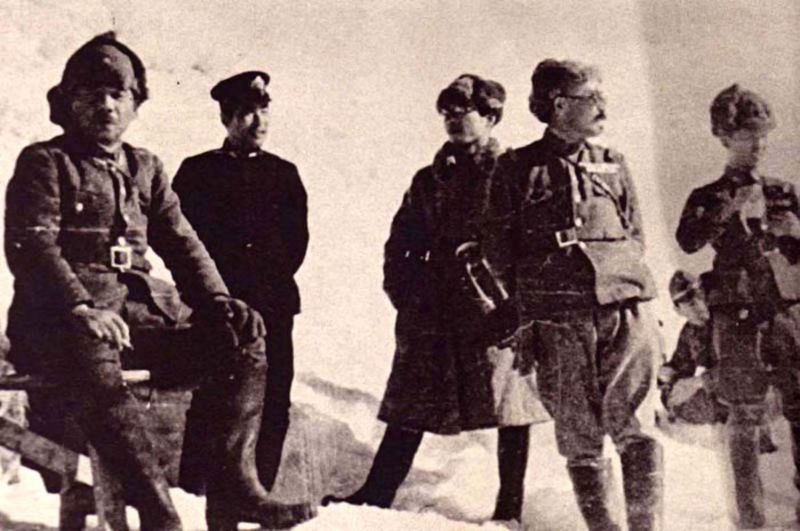 Japanese officers oversee operations in the Aleutians. 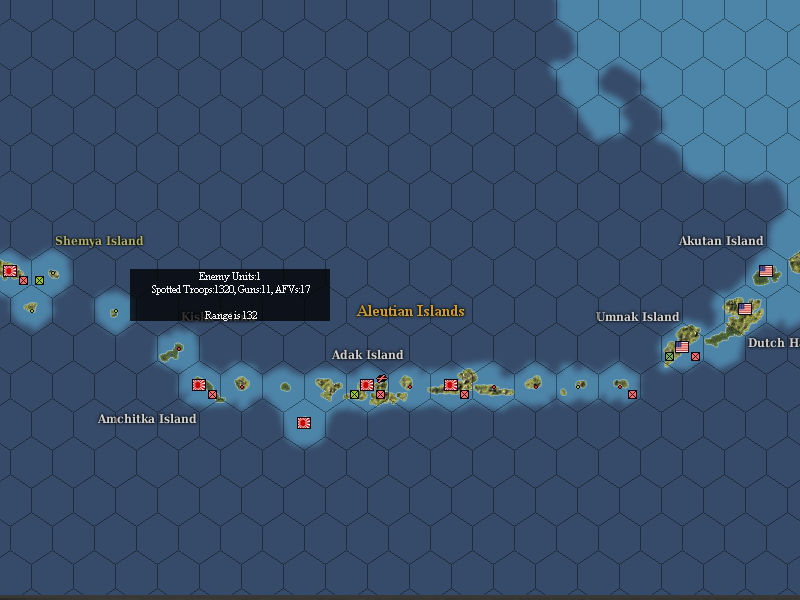 The American ships disappear, and the shore party doesn't seem to be reinforced. 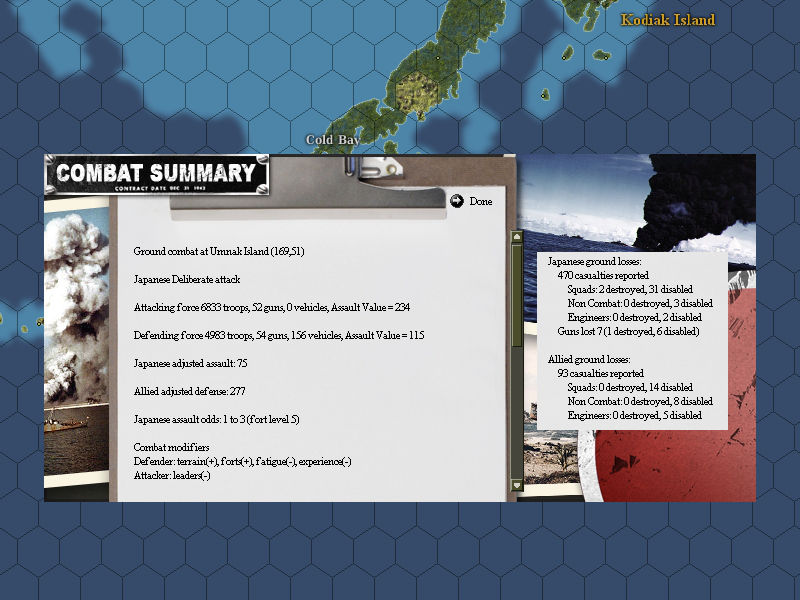 Unfotunately we have our own Alaskan quagmire on our hands - despite nominal superiority, we can't do much against the staggering level 5 fortifications on Umnak! 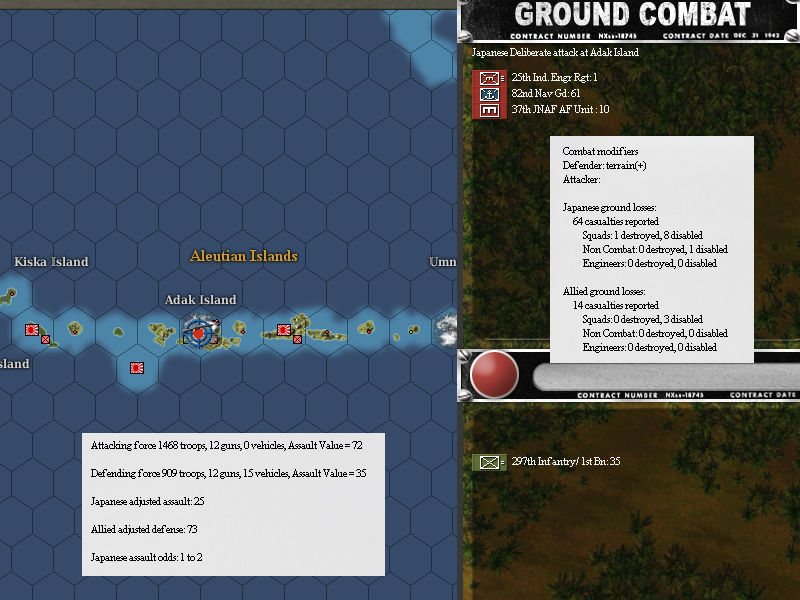 The opposing forces on Adak are too small to fight a decisive battle for control over the island.  Australia, our latest theatre of war, has ongoing operations on two separate fronts: 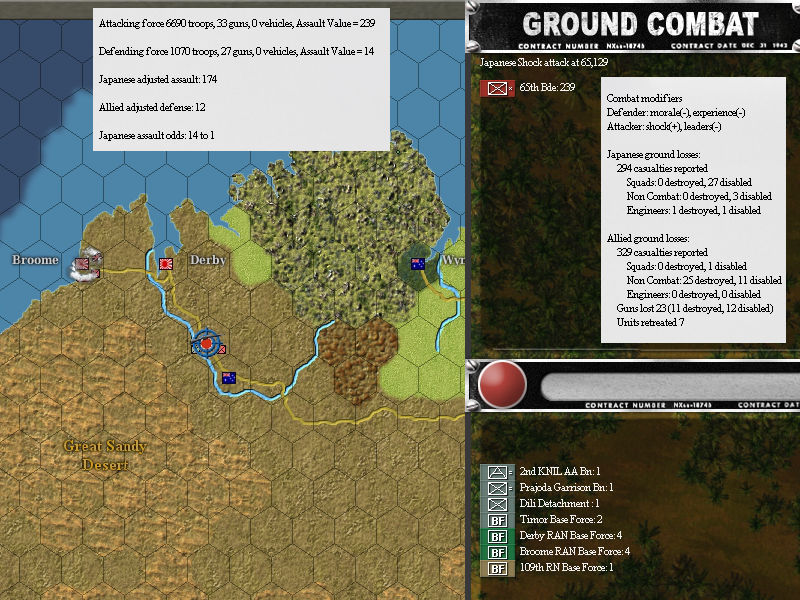 Australian garrison forces, reinforced by Dutch soldiers withdrawn from the DEI, are being pushed away from Broome along the long road to Darwin. NORTHERN STANDARD, 18 December 1931 posted:OLD TIME MEMORIES THE PEARLING GROUNDS OF BROOME, PART I 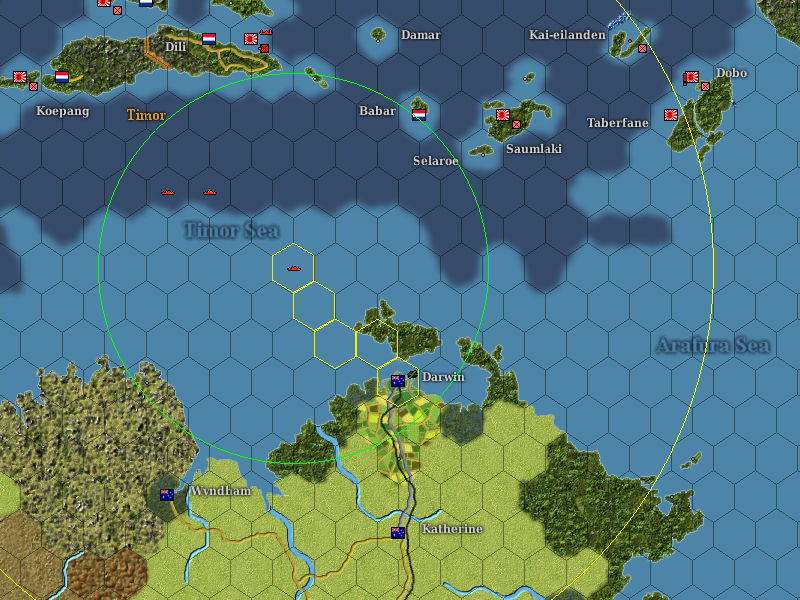 Darwin itself is being targeted by shore bombardment missions. 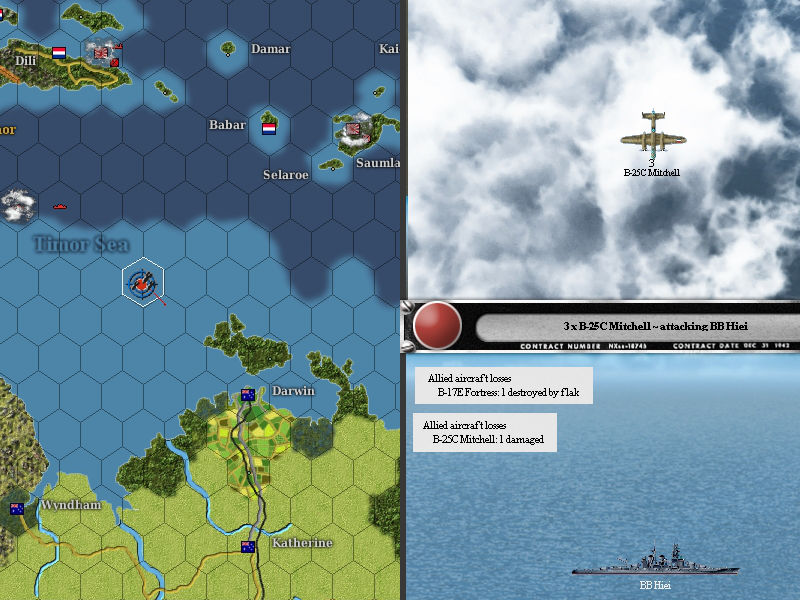 In hindsight, this may have been poorly thought out - there are B-17 stationed in Darwin. 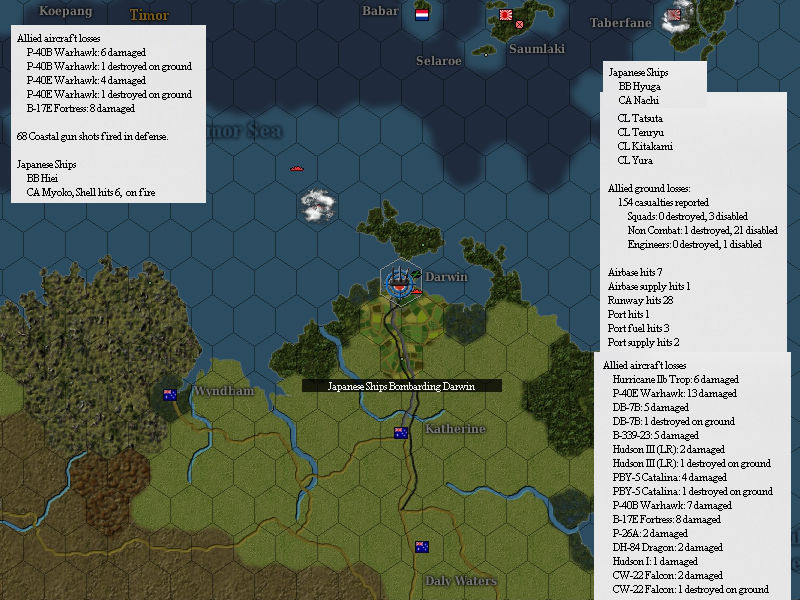 We do, however, disable most of the local air force. This should temporarily relieve pressure put by the Aussies on Timor, and allow safer resupplying. 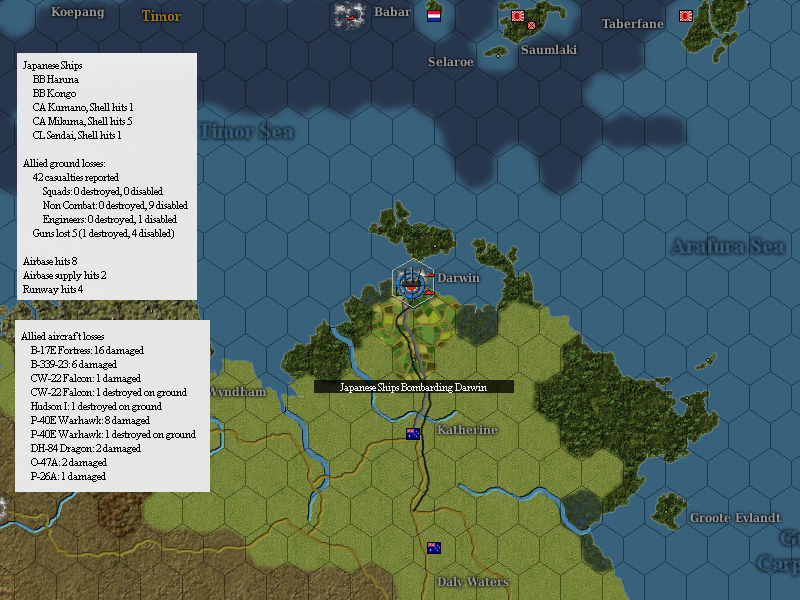 The bombardments come in multiple waves, and their effect isn't diminished over time. 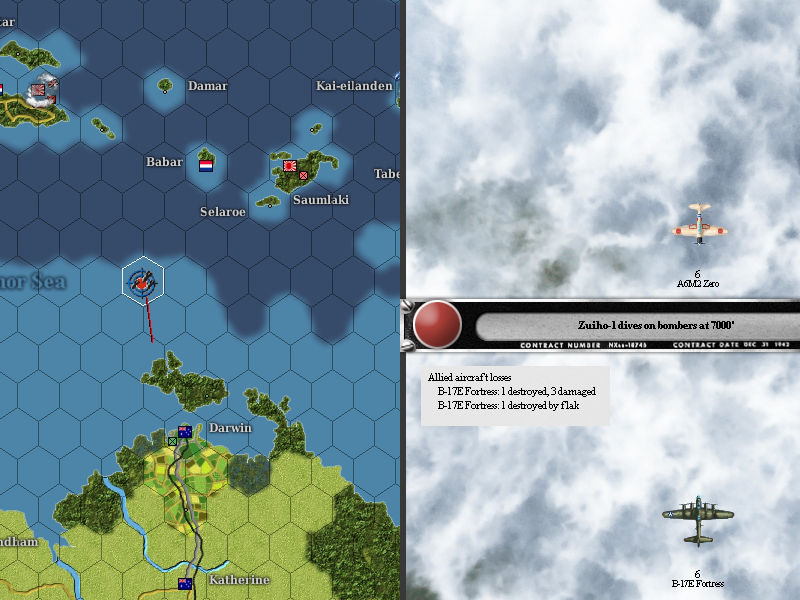 Turns out even B-17s can't stand against a concentrated Zero CAP. 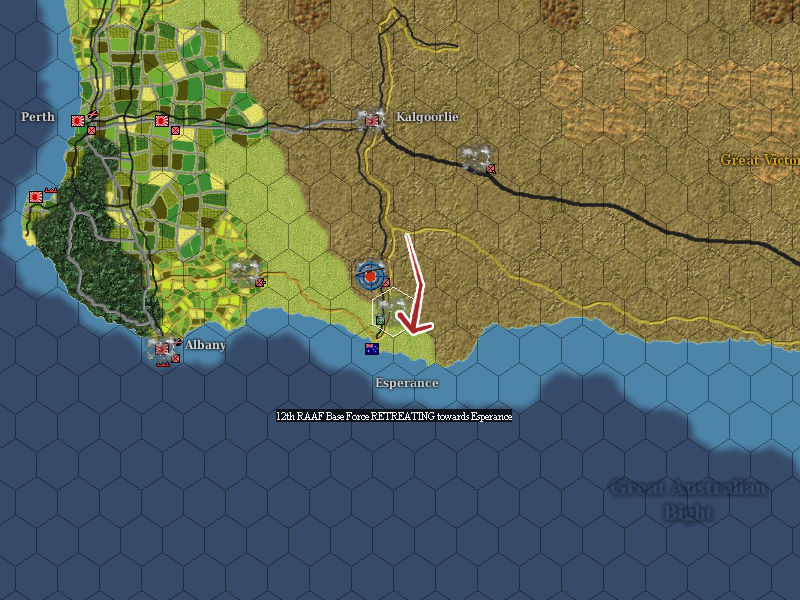 In the South-West we are about to complete our control of the coast. 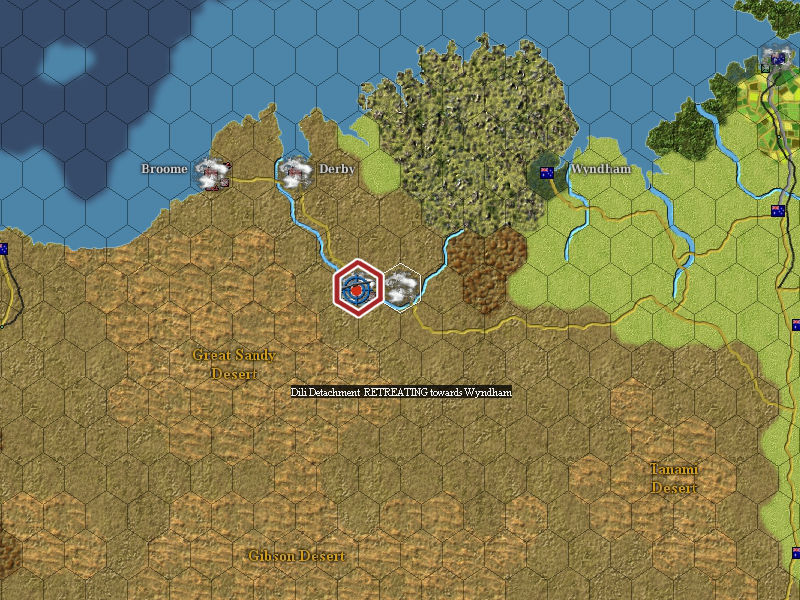 The retreating Australian column is defeated once more at the Fitzroy Crossing. 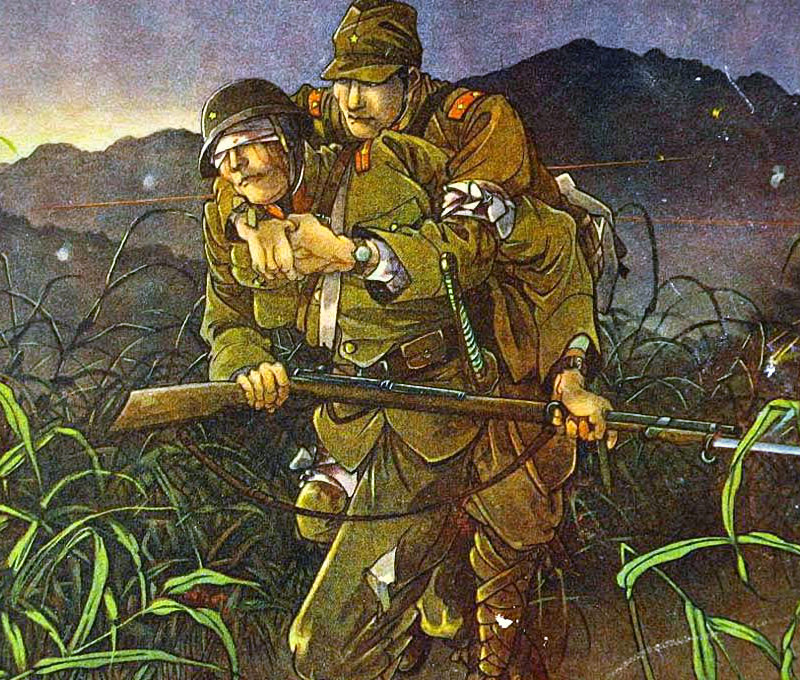
|
|
|
|
Pacific as hard as you can.
|
|
|
|
Yesssssss crush the allied pigdog. Also, I love those little ship info-dumps.
|
|
|
|
Glad to see this making a return!
|
|
|
|
This LP will never be over 
|
|
|
|
Just keep on smashing them up, steinrokkan! Glad to see this back online; watching others play these sorts of games is more fun than actually playing them 
|
|
|
|
The demands of the Samurai spirit once more passes to you Steinrokkan, do not let the Empire down. No pressure. Really, do not worry, the rumours about your Grey Hunter-sans near fatal sushi accident are almost certainly exaggerated. 
|
|
|
|
I am simply tickled pink to see the return of this thread. Banzai!
|
|
|
|
Nice to see this back, even if the AI being dumb as poo poo around
|
|
|
|
I love this. I love to see great players do the near-impossible in this sort of game.
|
|
|
|
Pimpmust posted:The demands of the Samurai spirit once more passes to you Steinrokkan, do not let the Empire down. If you are insinuating I crammed puffer fish into Grey's hard drive, you may find yourself accidentally ingesting the remaining bits of said puffer fish.
|
|
|
|
Awesome, glad to see this back on track!
|
|
|
|
Pan Asian Co Prosperity Sphere: The funniest name for the most brutal regime of conquest. Good to see this back!
|
|
|
|
Insanely cool and good that you decided to pick up this LP again!
|
|
|
|
steinrokkan posted:If you are insinuating I crammed puffer fish into Grey's hard drive, you may find yourself accidentally ingesting the remaining bits of said puffer fish. Commanders screwing with each other just to get the spotlight? Truly, you are really striving to give us the authentic Imperial Japan military experience 
|
|
|
|
So glad this is back, I loved it when it was first around and the format of week-long summaries is nice too because it allows seeing a whole operation building up and executing in just a couple updates.
|
|
|
|
Don't you dare hurt the Boise.
|
|
|
|
Missed this LP thank you for bringing it back Steinrokkan!
|
|
|
|
post your favourite Japanese propaganda video itt https://www.youtube.com/watch?v=6hceNfhDFWY
|
|
|
|
I'm glad to see this LP back! 
|
|
|
|
At Singers, I'd at this point just rest for a week or so while firing off daily bombardment attacks and doing bombing runs, then throw a big deliberate attack in. Then repeat that until the place cracks. Sometimes you just gotta do an old-fashioned siege.
|
|
|
|
Just came across an article that might be very interesting to this thread: The mighty Japanese battleship, Musashi, has been found! The BBC reports. It seems that she rests at a depth of about a kilometre.
|
|
|
|
David Corbett posted:Just came across an article that might be very interesting to this thread: She was found by the guy responsible for SpaceShipOne - I anticipate Space Battleship Musashi becoming reality in near future.
|
|
|
|
Happy to see this LP back in action.
|
|
|
|
Glad to see the LP return! I love the old news articles you dig up, especially with how casual the racism is. Quite a different time.
|
|
|
|
It's back! Since the old thread is in the archives, could you please repost the last strategic overview map? I don't remember where all the front lines are, especially in China.
|
|
|
|
I guess your LP will have to do, since GH's died. Oh well. You're doing waaaaay better than Grey though. My question: How troop heavy is Australia? Do you have a reasonable shot at occupying Sydney?
|
|
|
|
VostokProgram posted:It's back! Since the old thread is in the archives, could you please repost the last strategic overview map? I don't remember where all the front lines are, especially in China. This is the map at the beginning of June:  A White Guy posted:I guess your LP will have to do, since GH's died. Oh well. You're doing waaaaay better than Grey though. My question: How troop heavy is Australia? Do you have a reasonable shot at occupying Sydney? Australia has got quite a lot of troops, the question is when and where they'll bring them to play. They can't currently just load them on trains because railroads are either occupied by me, or non-existent around the frontlines, so that should buy me some time to reinforce. I'm definitely not going to attack Sydney, Brisbane or any of the large cities in the south-east any time soon: In addition to triggering extra Allied divisions to spawn, I currently need troops elsewhere.
|
|
|
|
I'm not entirely sure I understand why you're invading Australia. Is it just because you've snookered the AI into letting you or is there a wider strategic reason? It's been a bit of a gap between the LP ending the first time and picking up again and I can't remember the purpose of the invasion.
|
|
|
|
Night10194 posted:I'm not entirely sure I understand why you're invading Australia. Is it just because you've snookered the AI into letting you or is there a wider strategic reason? It's been a bit of a gap between the LP ending the first time and picking up again and I can't remember the purpose of the invasion. You can't spell Australasia without Australia. Honestly, there's not much of a rational reason to invade Australia besides capturing Perth and Darwin, and making the Allies' life marginally harder, and to force the enemy to fight you on their own turf for a bit longer before they get to invade your core territory (which doesn't always work against human players - who owns what in Australia can be ignored as long as you control at least Sydney and Melbourne / Brisbane). Mostly I just think that fighting in Australia is fun - mobile warfare over the vast stretches of empty countryside is a nice change of pace compared to the usual tug of war.
|
|
|
|
So it's hubris. Excellent! Hubris is Imperial Japan's middle name, after all!
|
|
|
|
What happens to China if you manage to drive all the way to Urumqi (or beyond?)
|
|
|
|
Night10194 posted:So it's hubris. Excellent! Hubris is Imperial Japan's middle name, after all! Hubris and Greed are the true enemies in strategy games.
|
|
|
|
gradenko_2000 posted:What happens to China if you manage to drive all the way to Urumqi (or beyond?) I think the main prize in China is city where units respawn after destruction. They start seriously understrength, but in a situation where Allies open supply road to China there won't be any units to fill.
|
|
|
|
gradenko_2000 posted:What happens to China if you manage to drive all the way to Urumqi (or beyond?) Sadly the answer is nothing. As a consolidation price Urumqi at least has some oil wells. alex314 posted:I think the main prize in China is city where units respawn after destruction. They start seriously understrength, but in a situation where Allies open supply road to China there won't be any units to fill. True, but keep in mind that a huge part of why the respawns are weak has to do with the usual lack of supply. On the difficulty level I chose Chungking produces enough extra supply to make this a non-issue.
|
|
|
|
steinrokkan posted:True, but keep in mind that a huge part of why the respawns are weak has to do with the usual lack of supply. On the difficulty level I chose Chungking produces enough extra supply to make this a non-issue.
|
|
|
|

|
| # ? Apr 27, 2024 01:48 |
|
steinrokkan posted:This is the map at the beginning of June: Thanks! We seem to be doing well, how would you rate our chances of running out the clock? What about automatic victory?
|
|
|



































